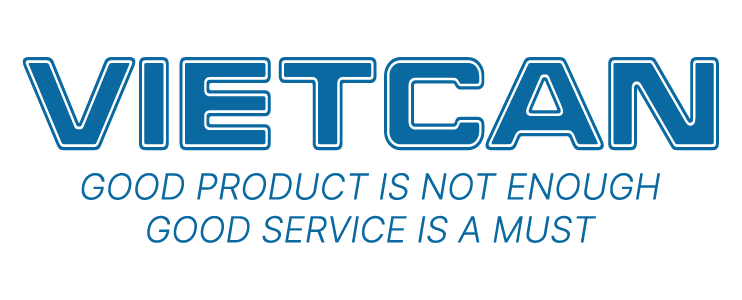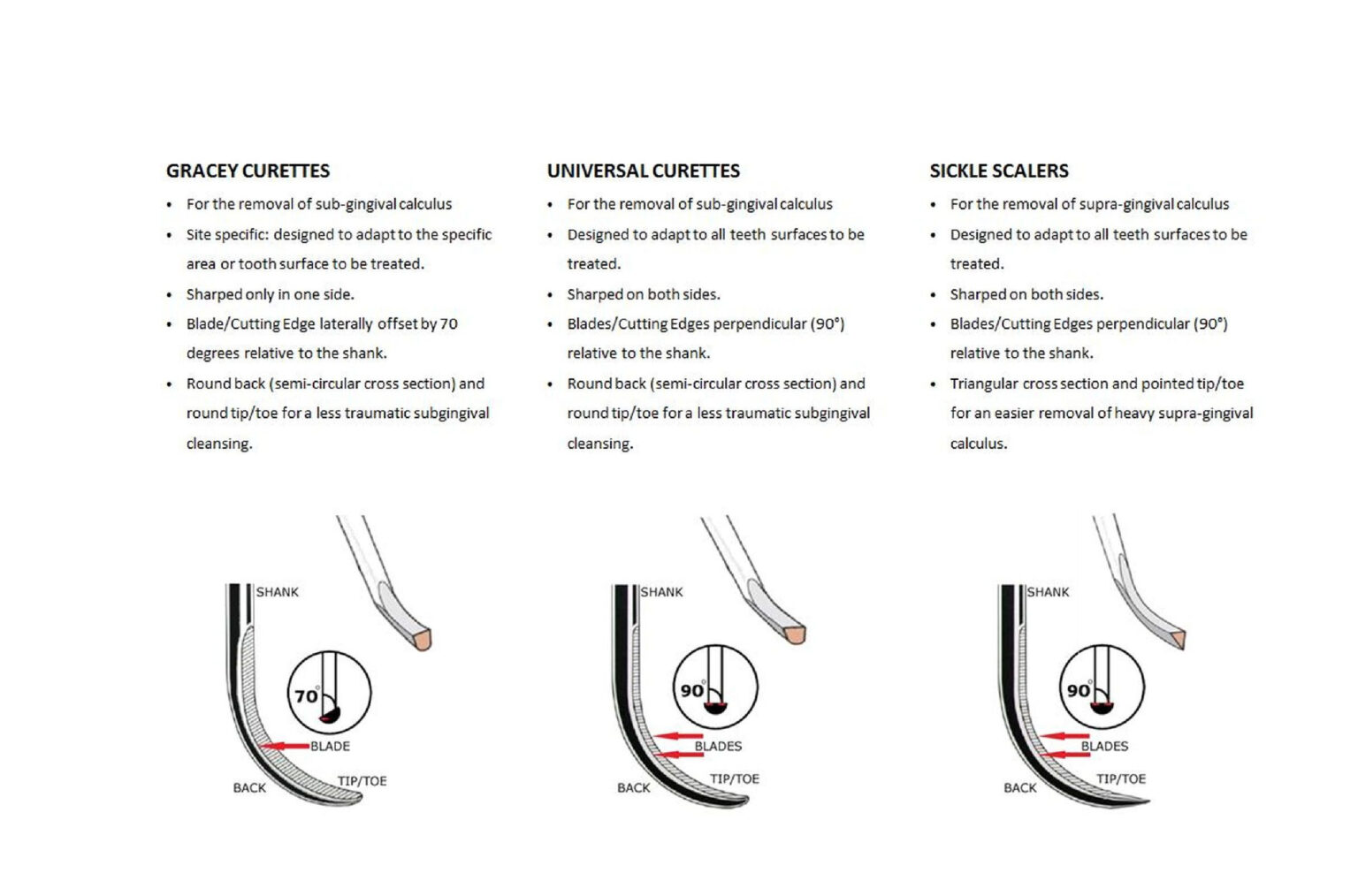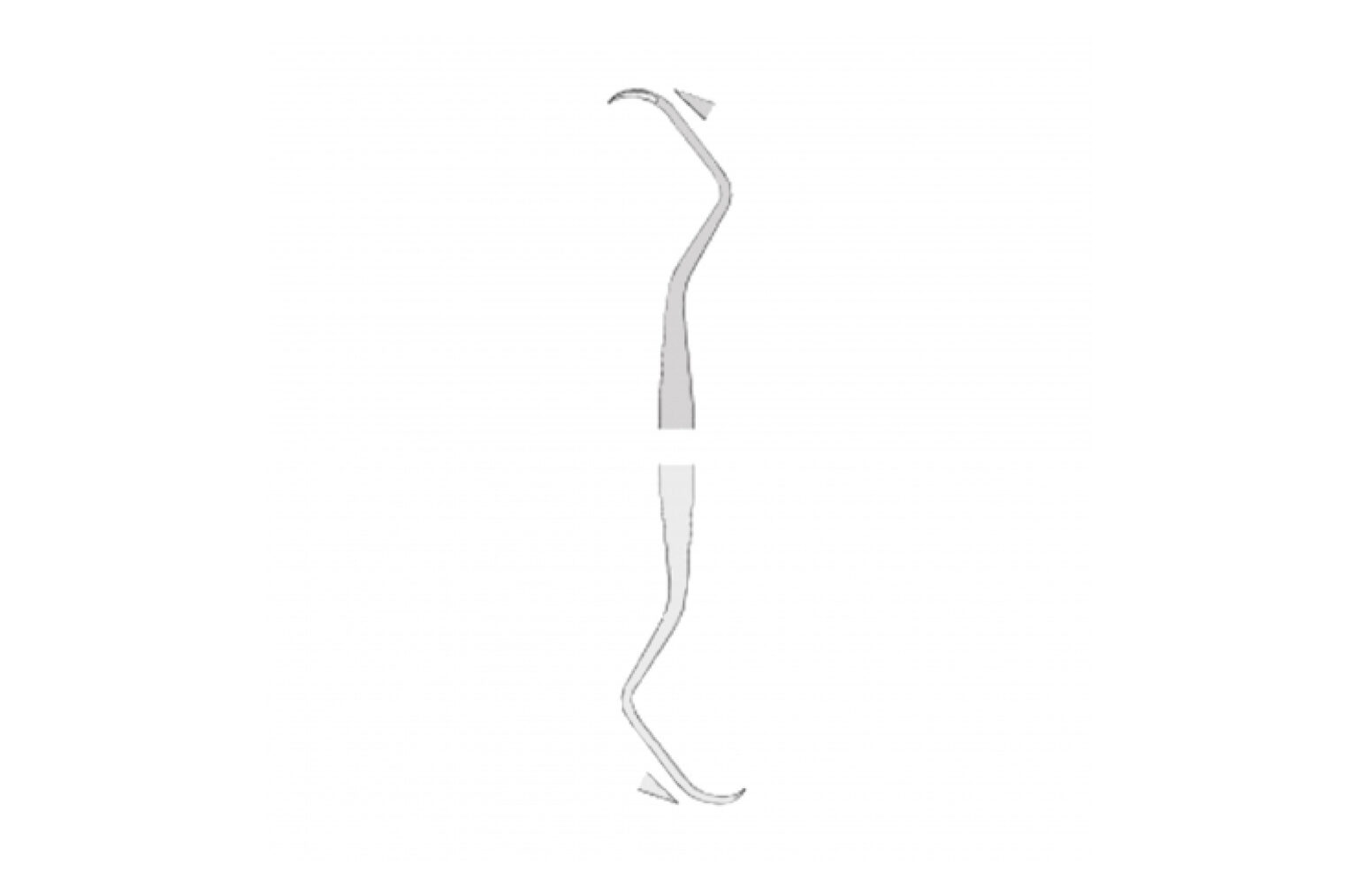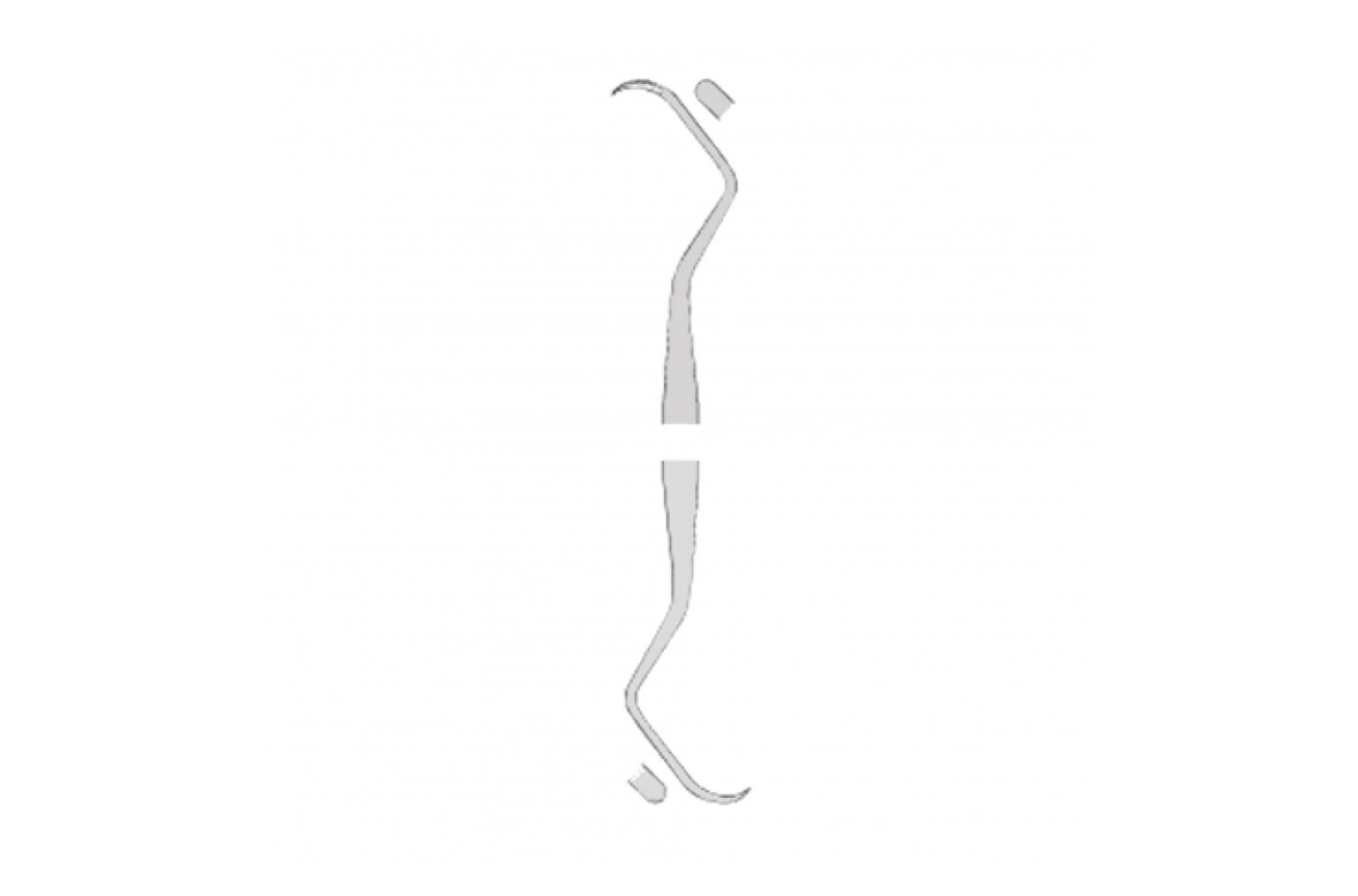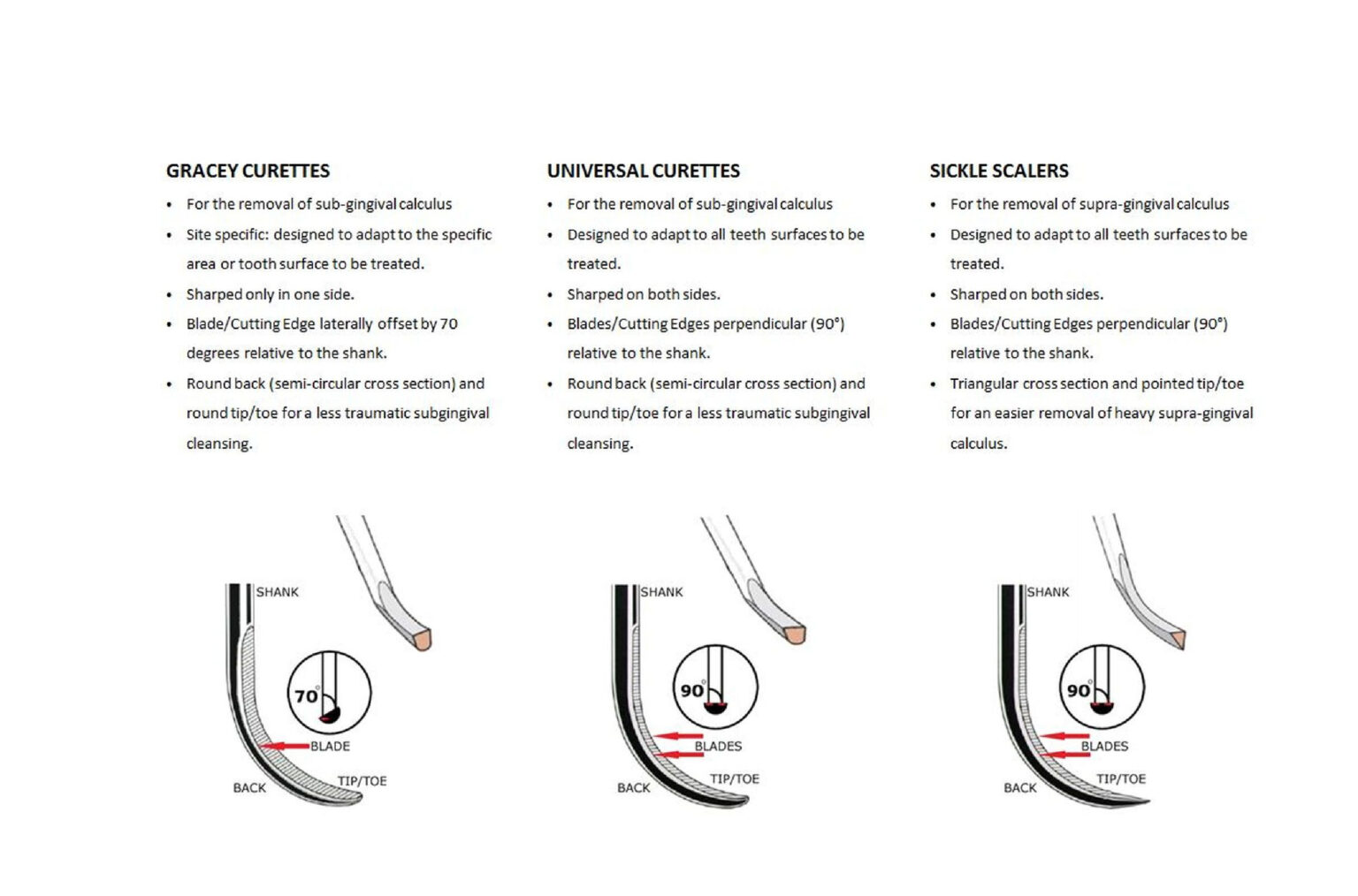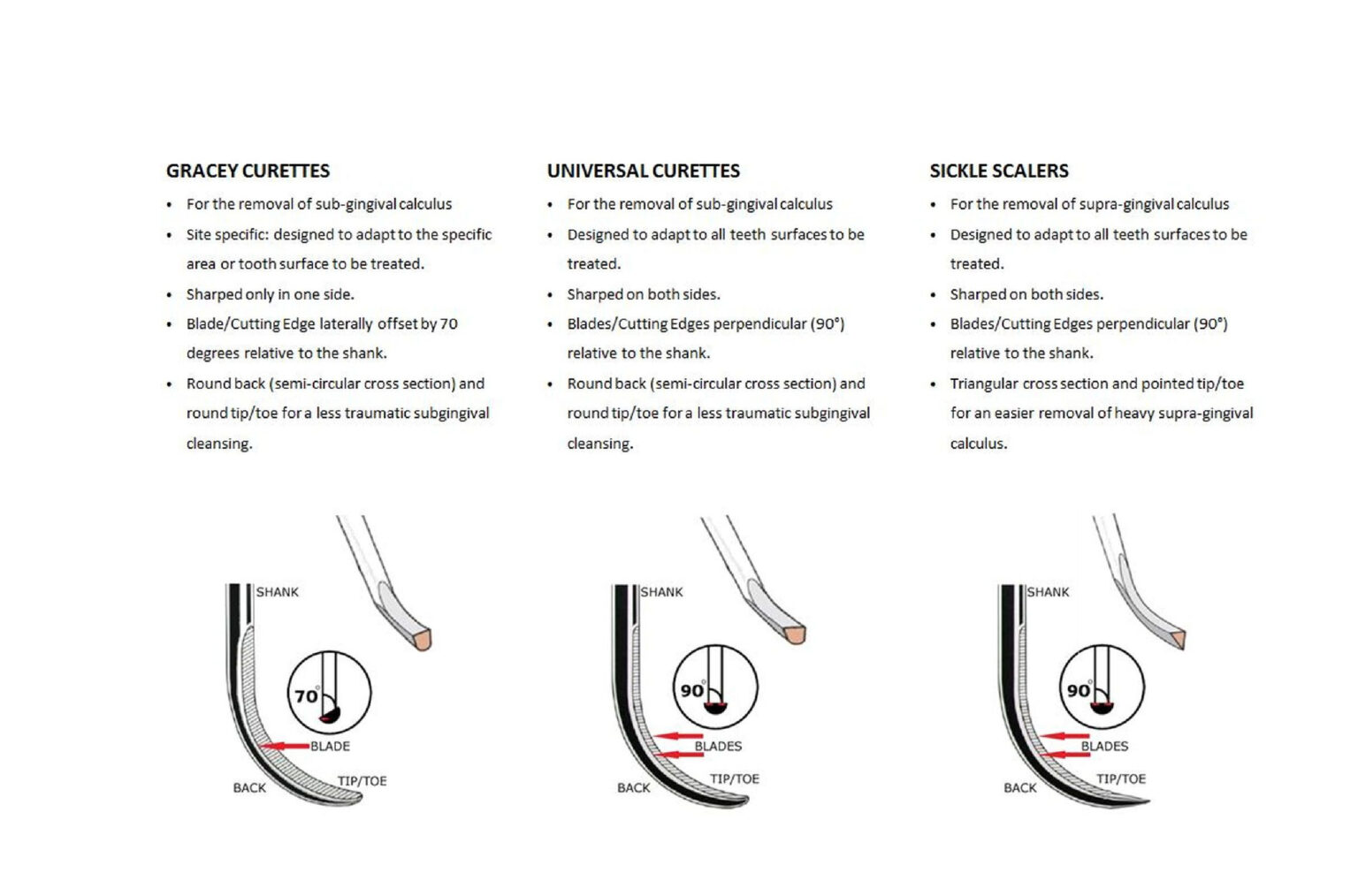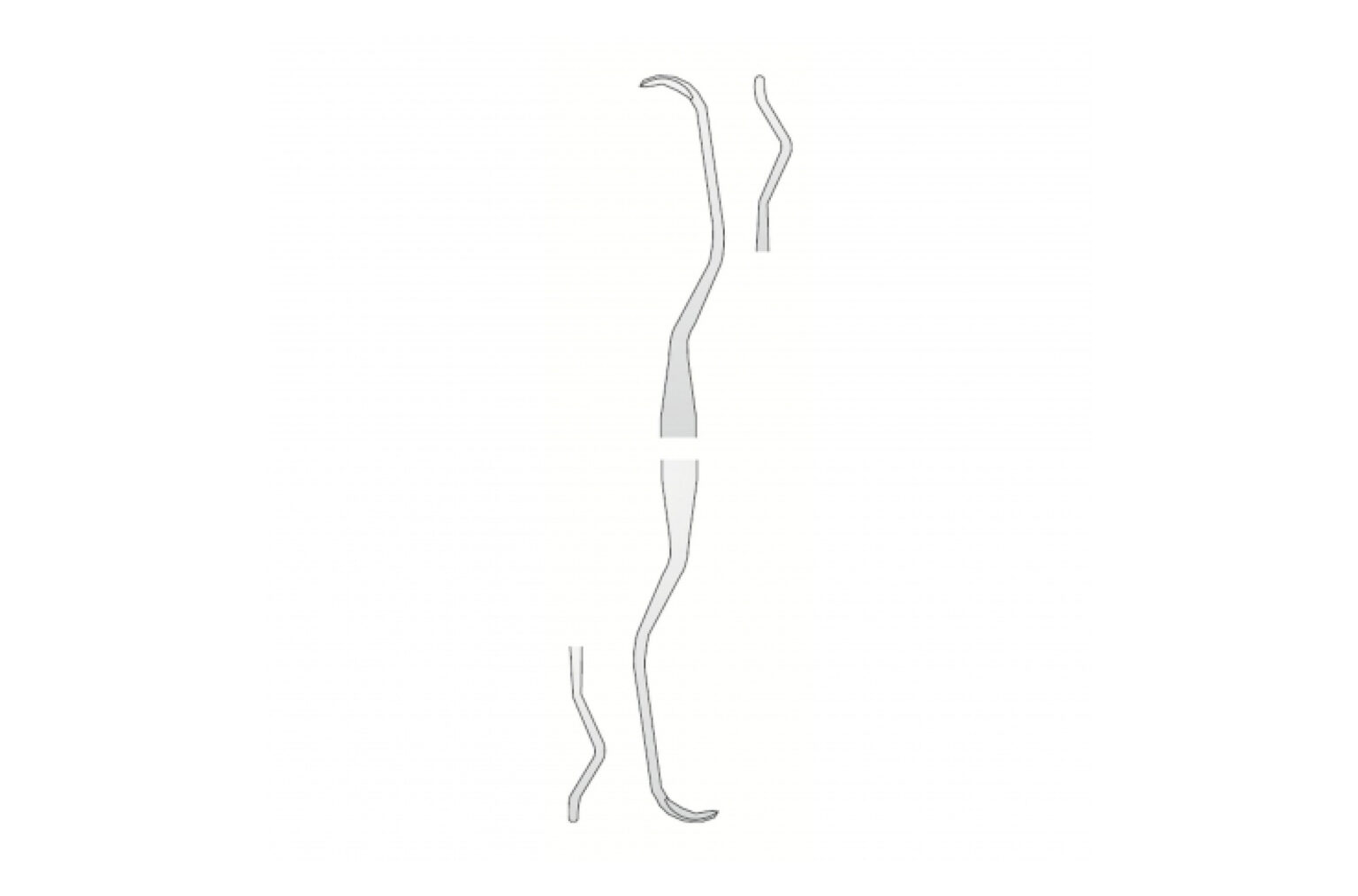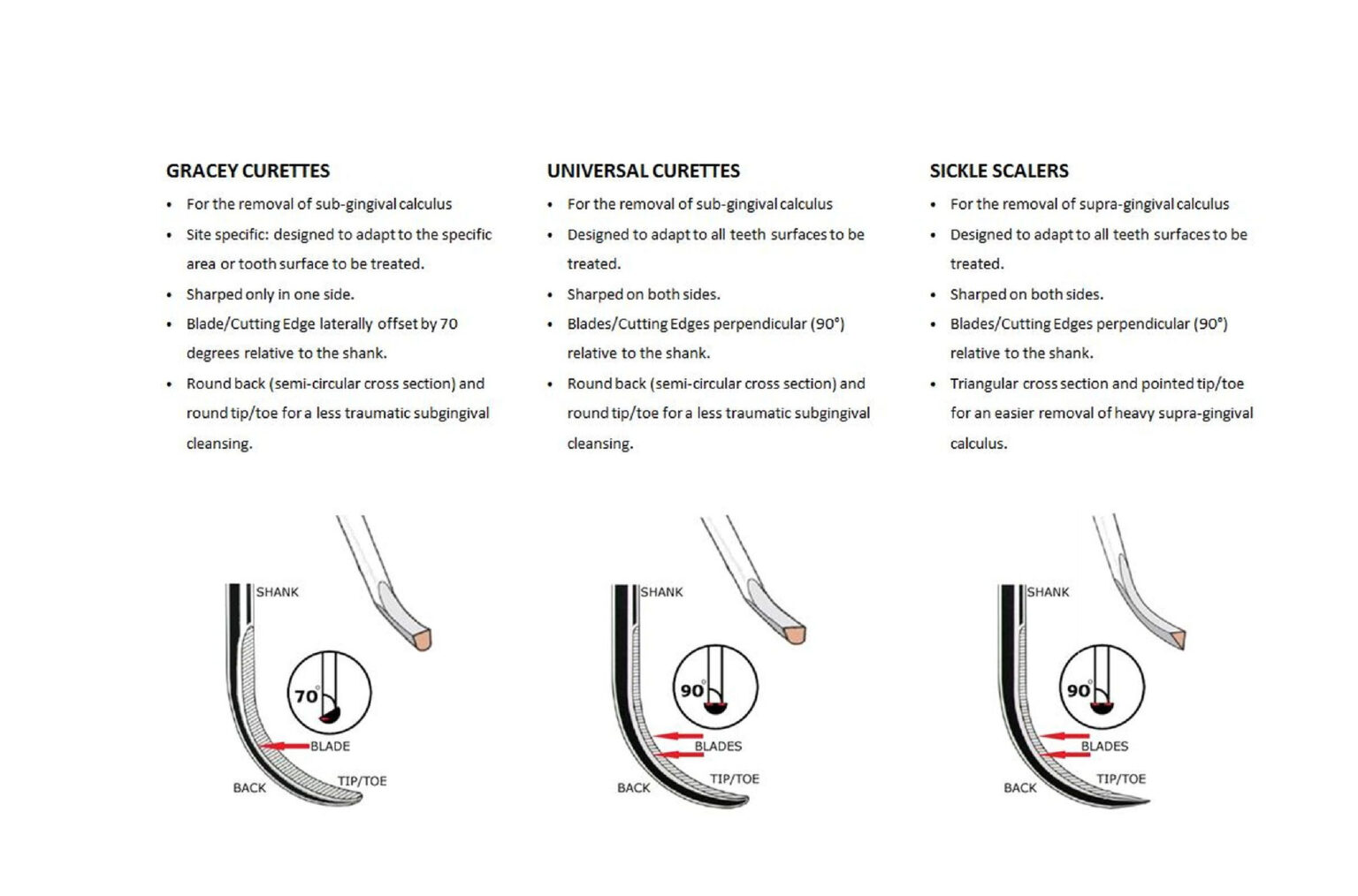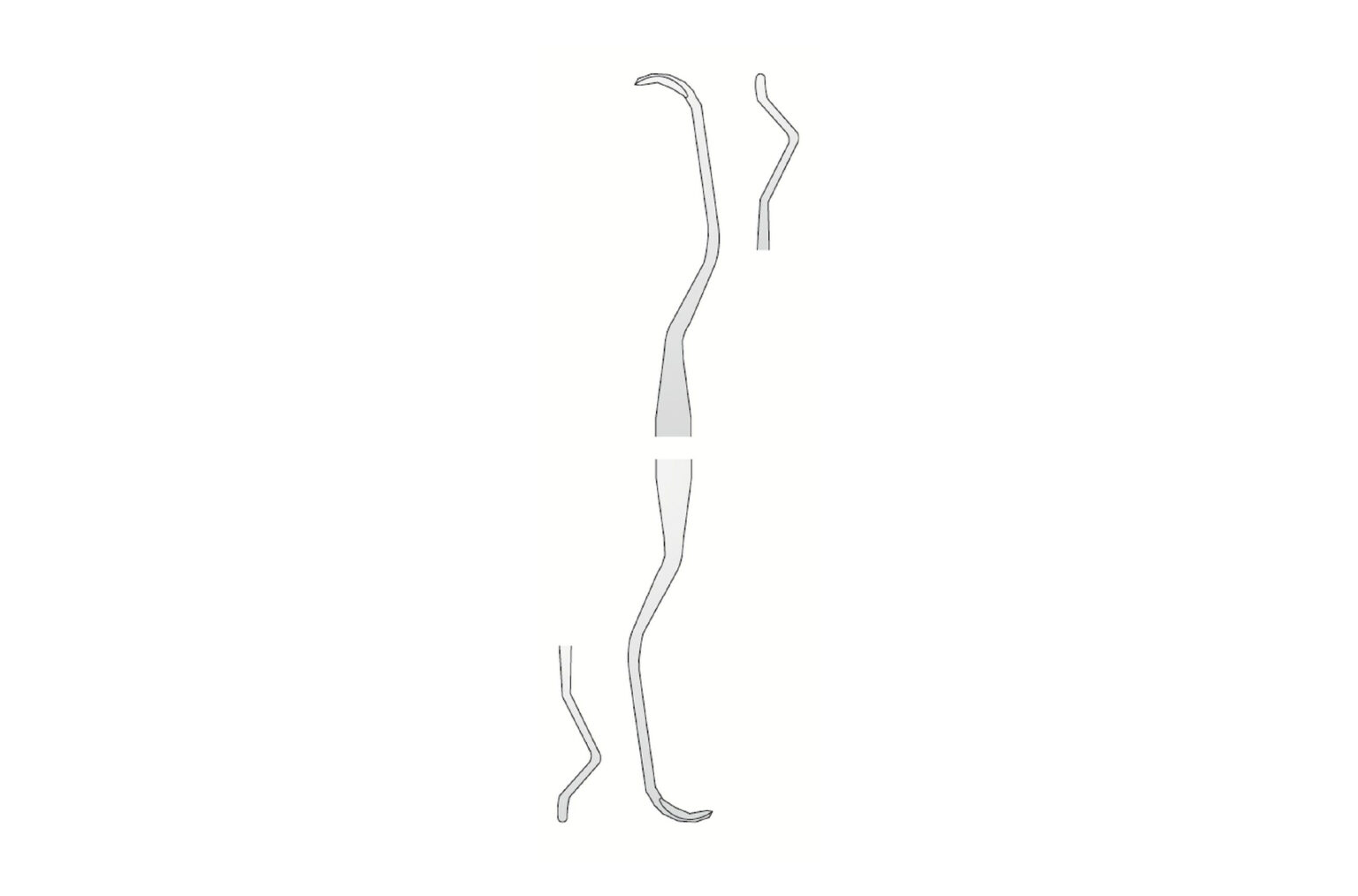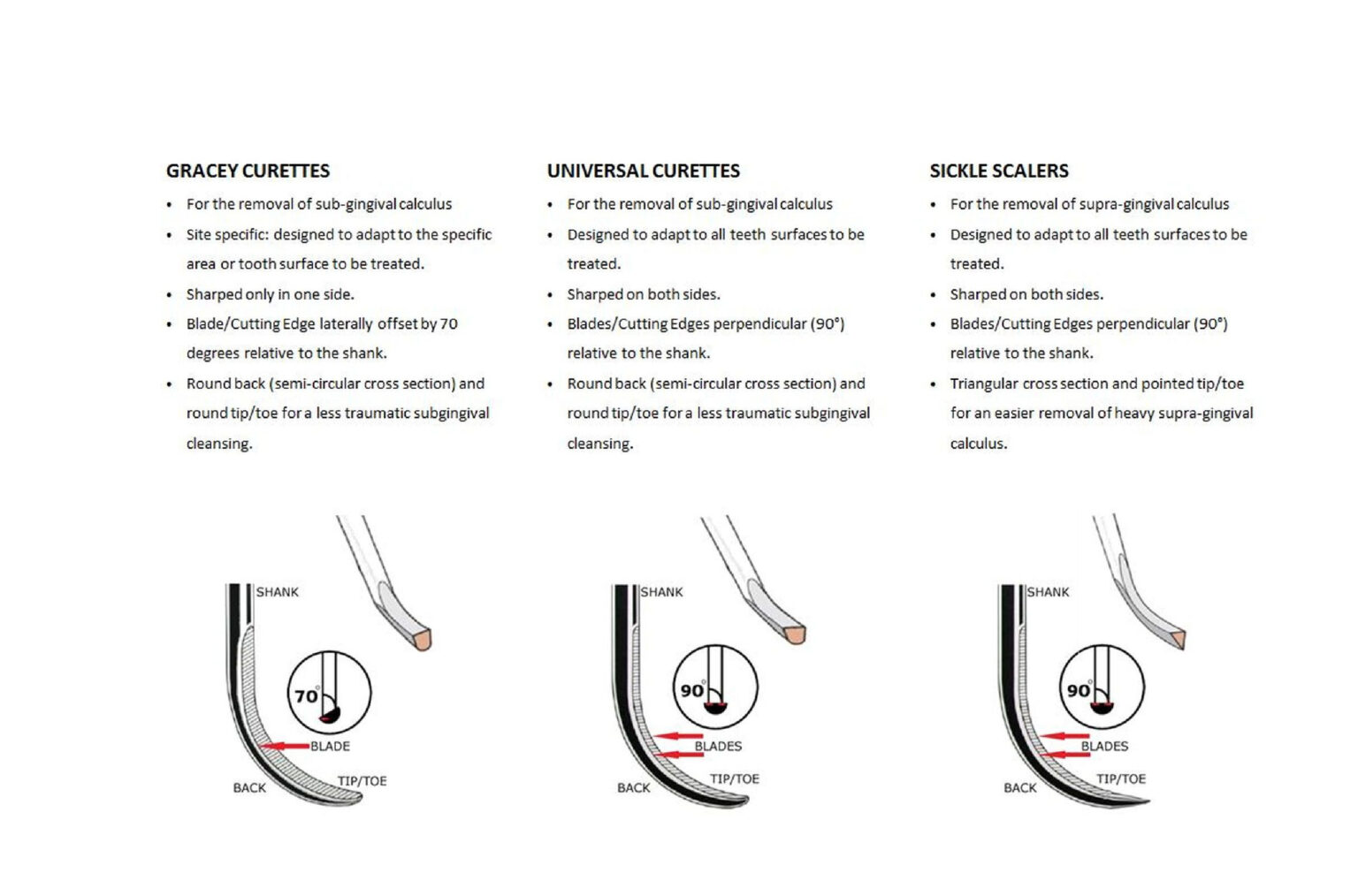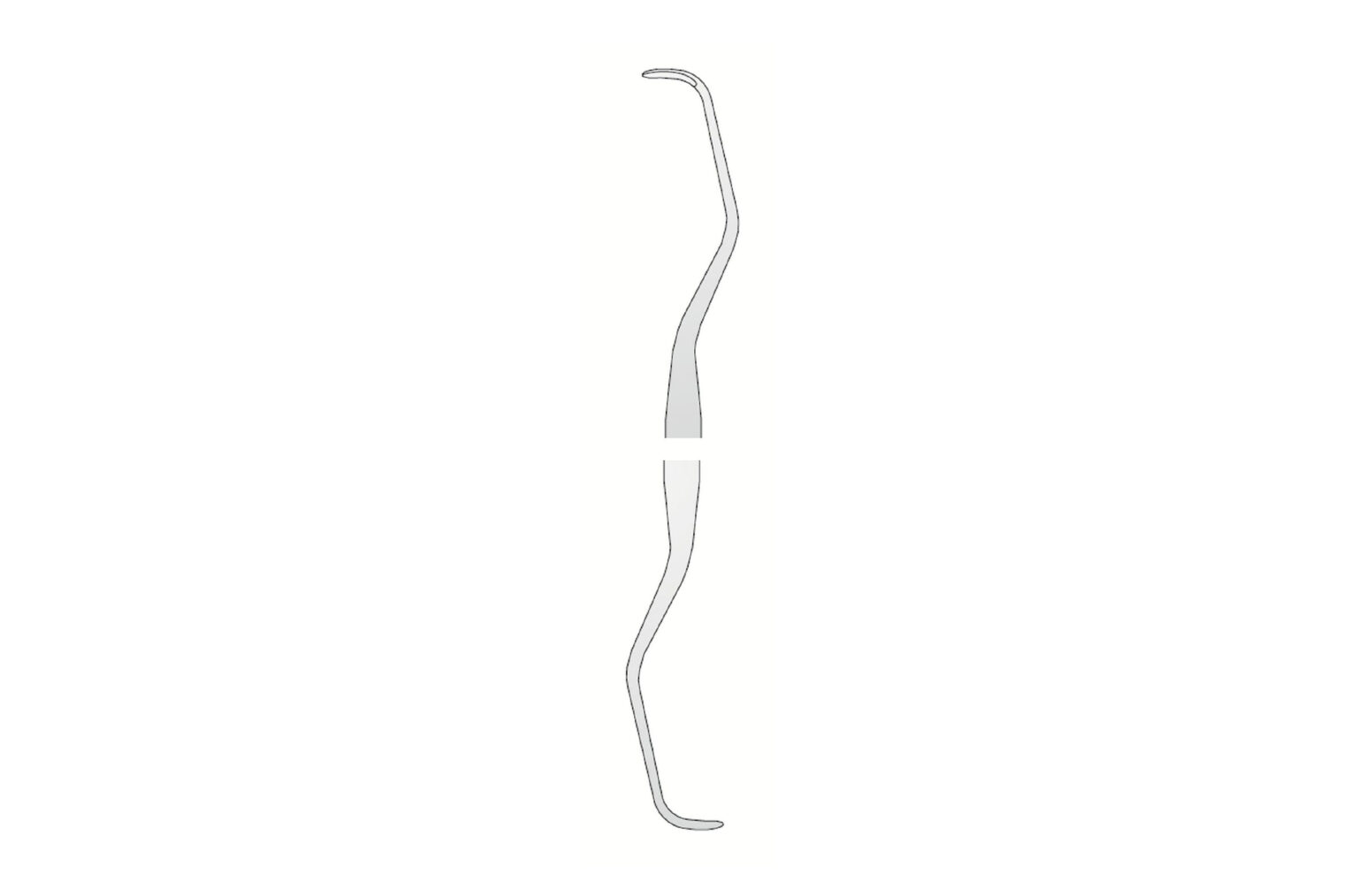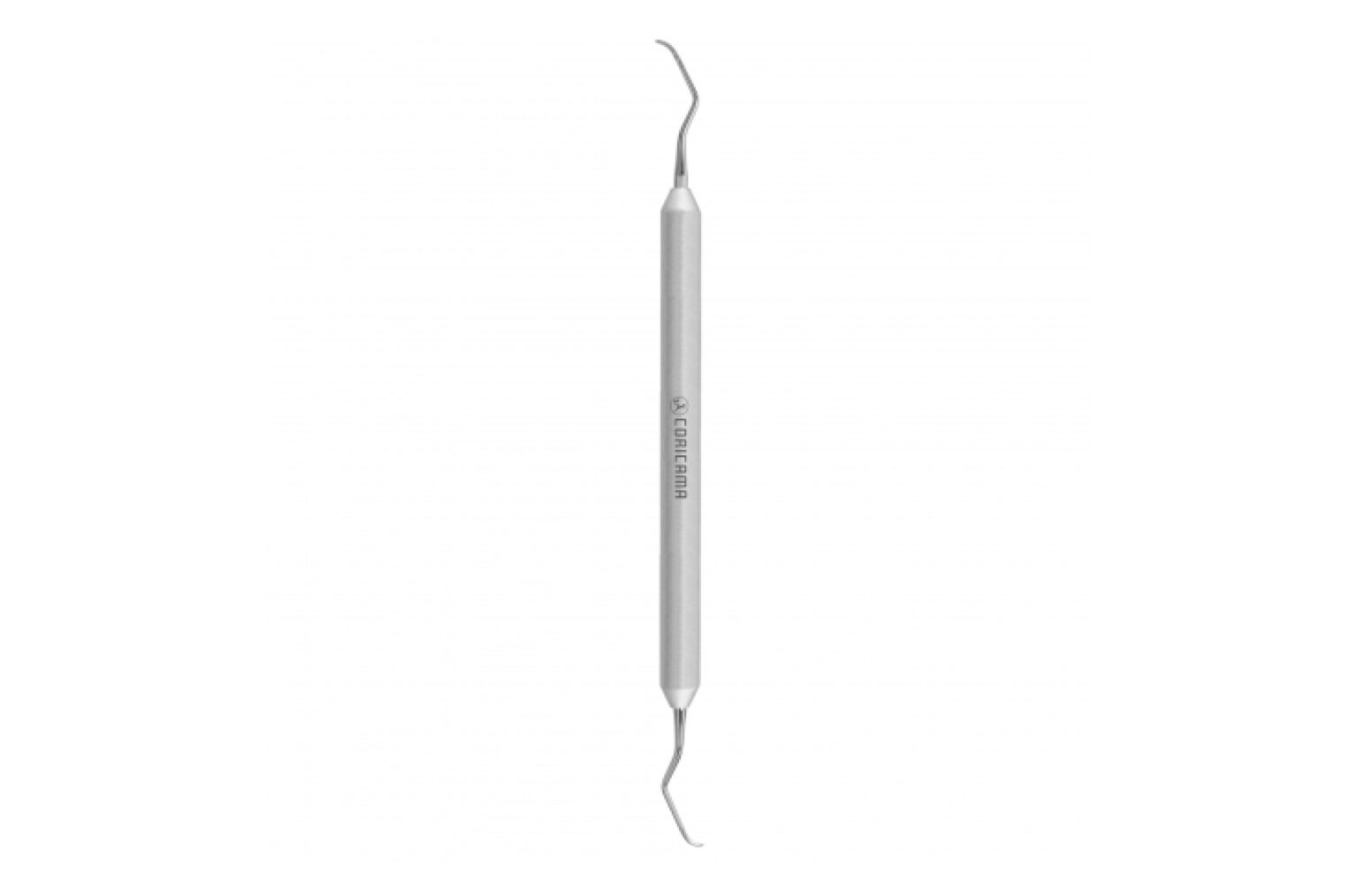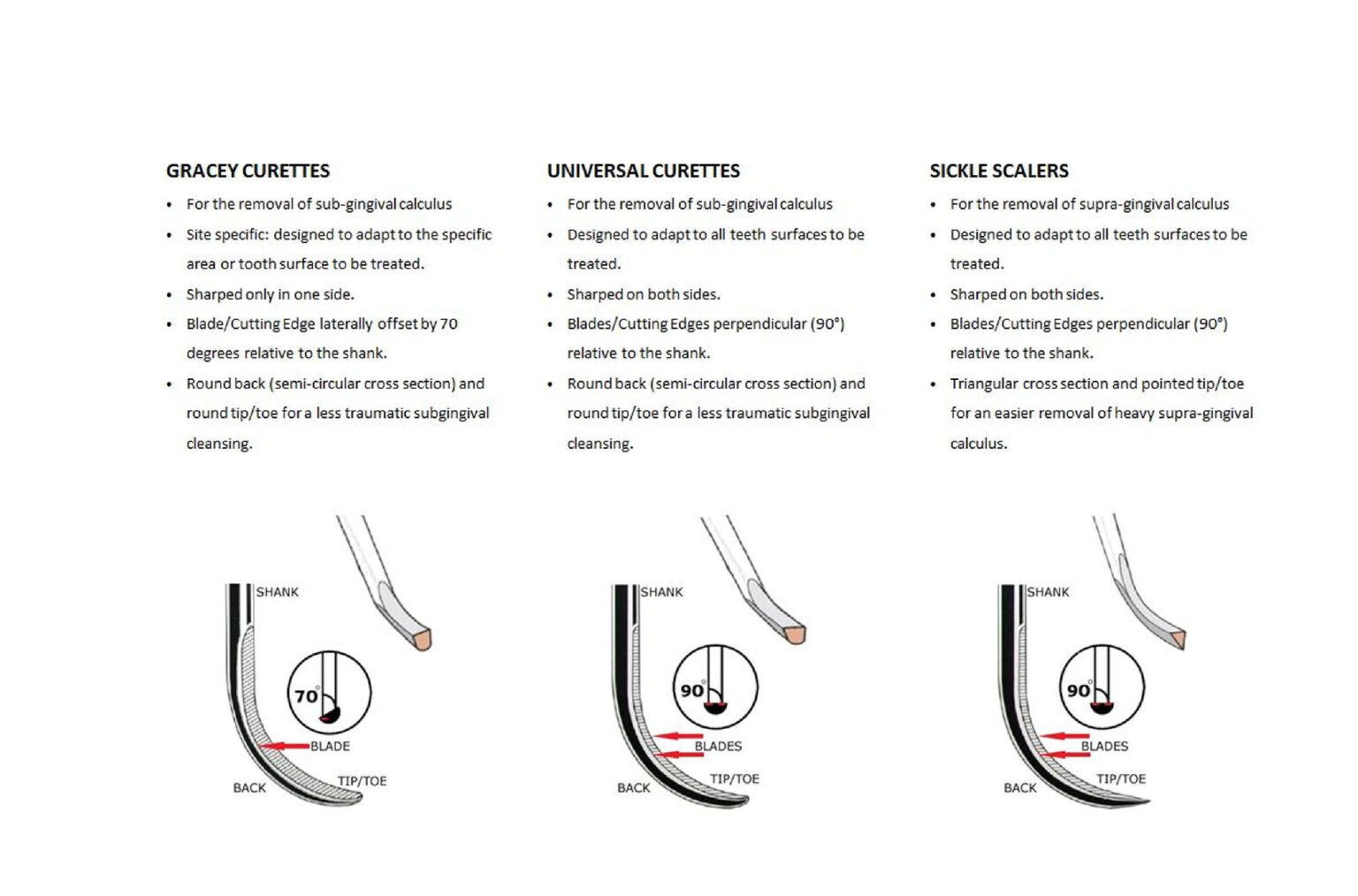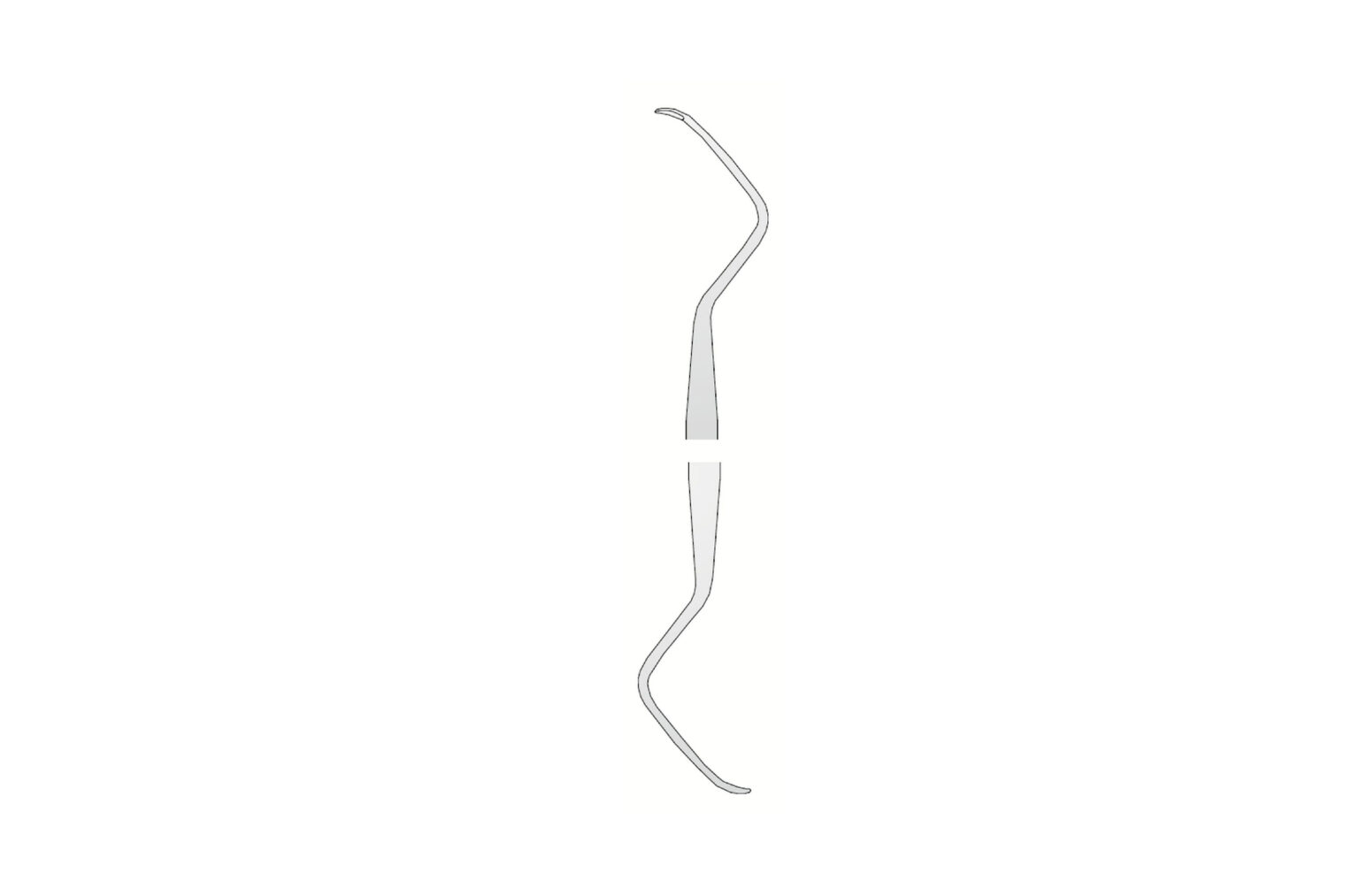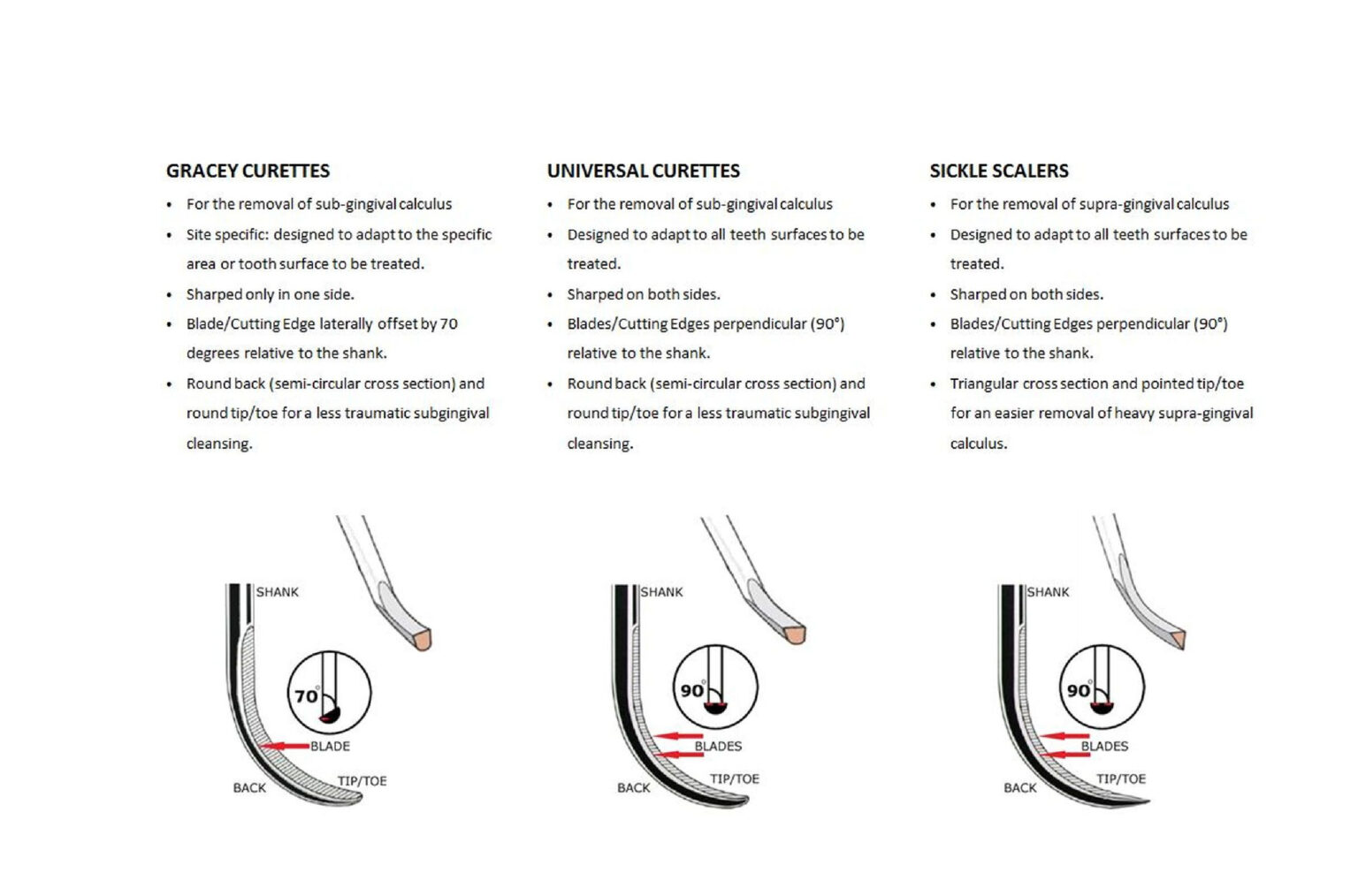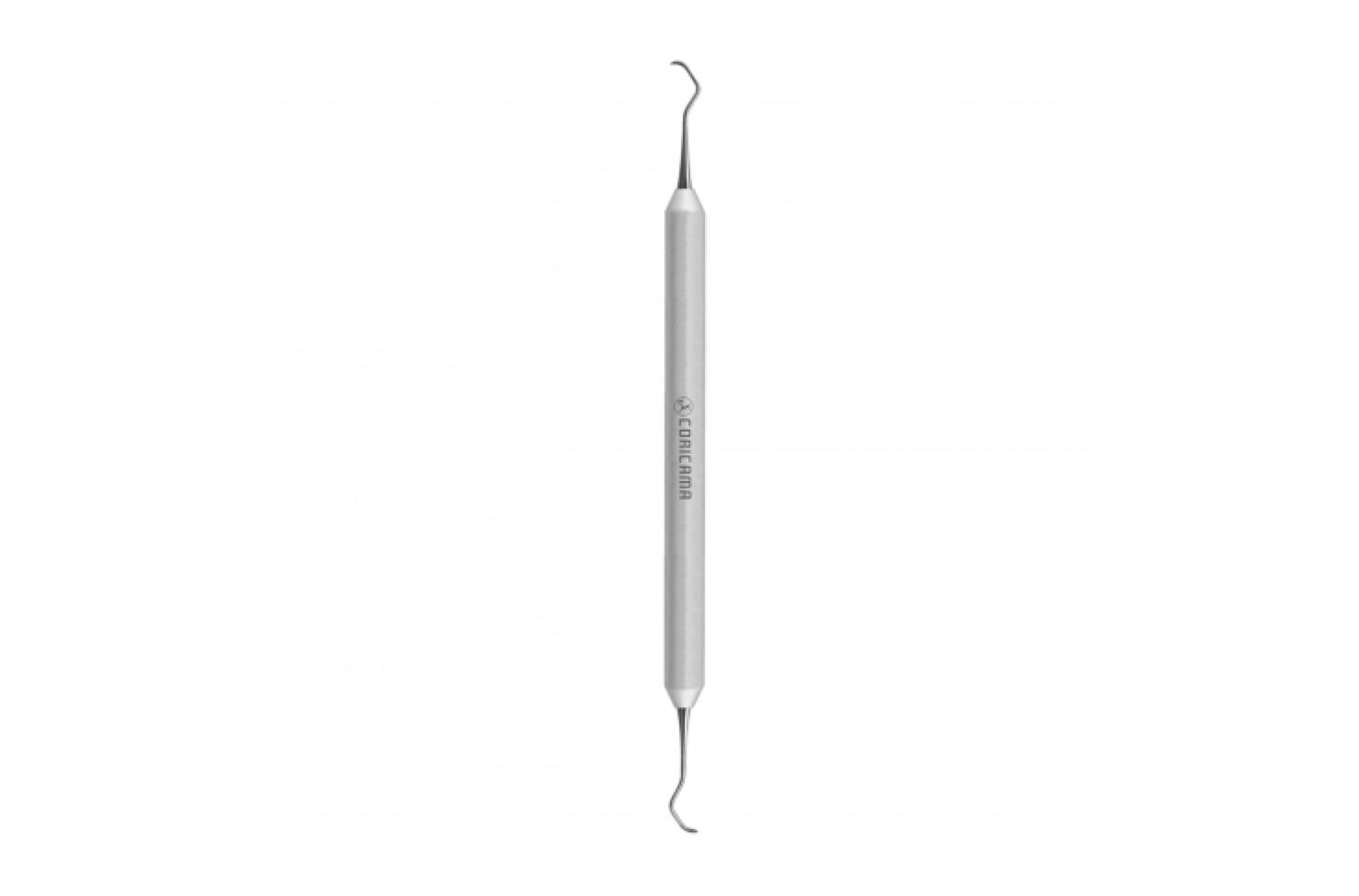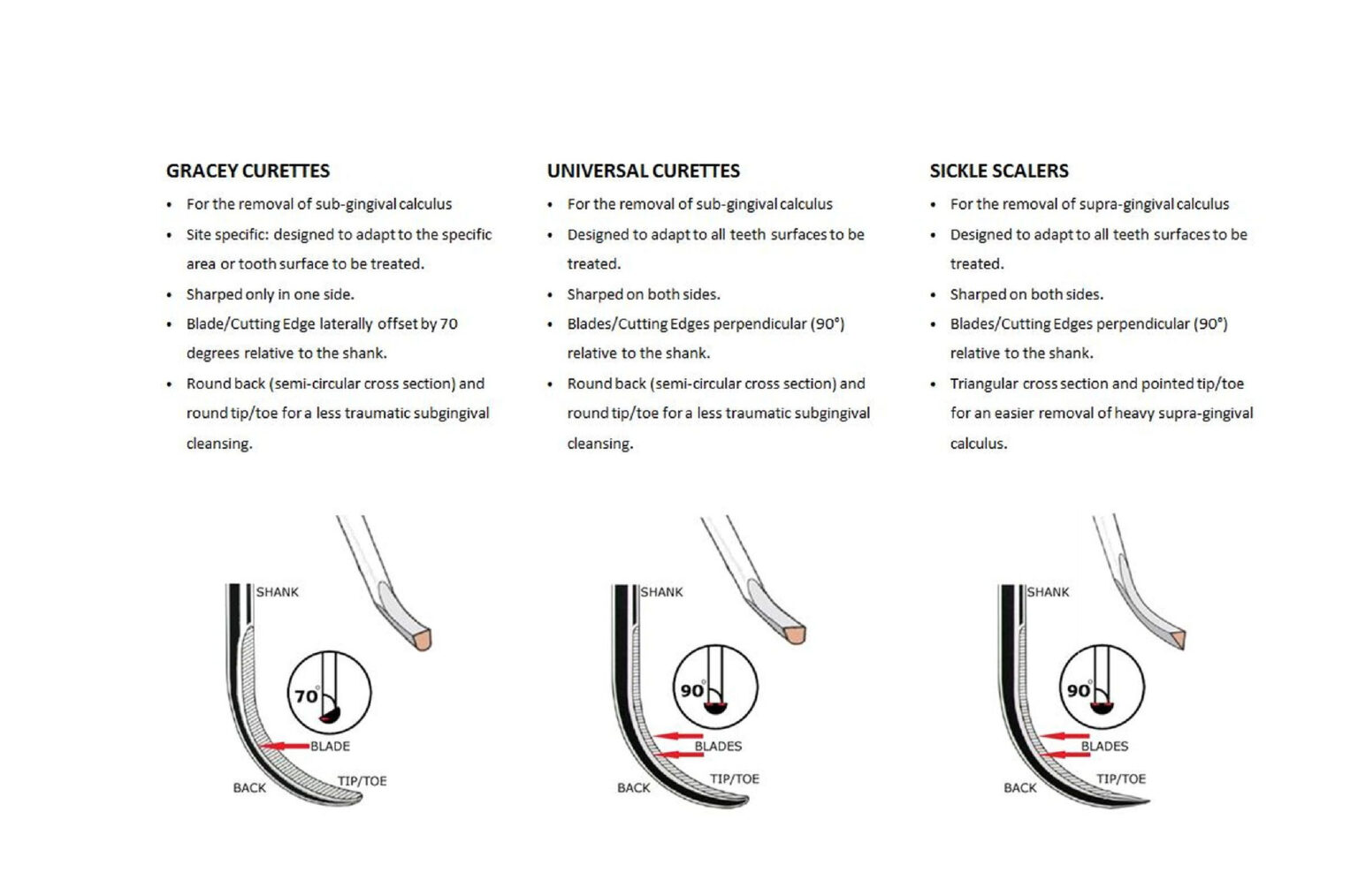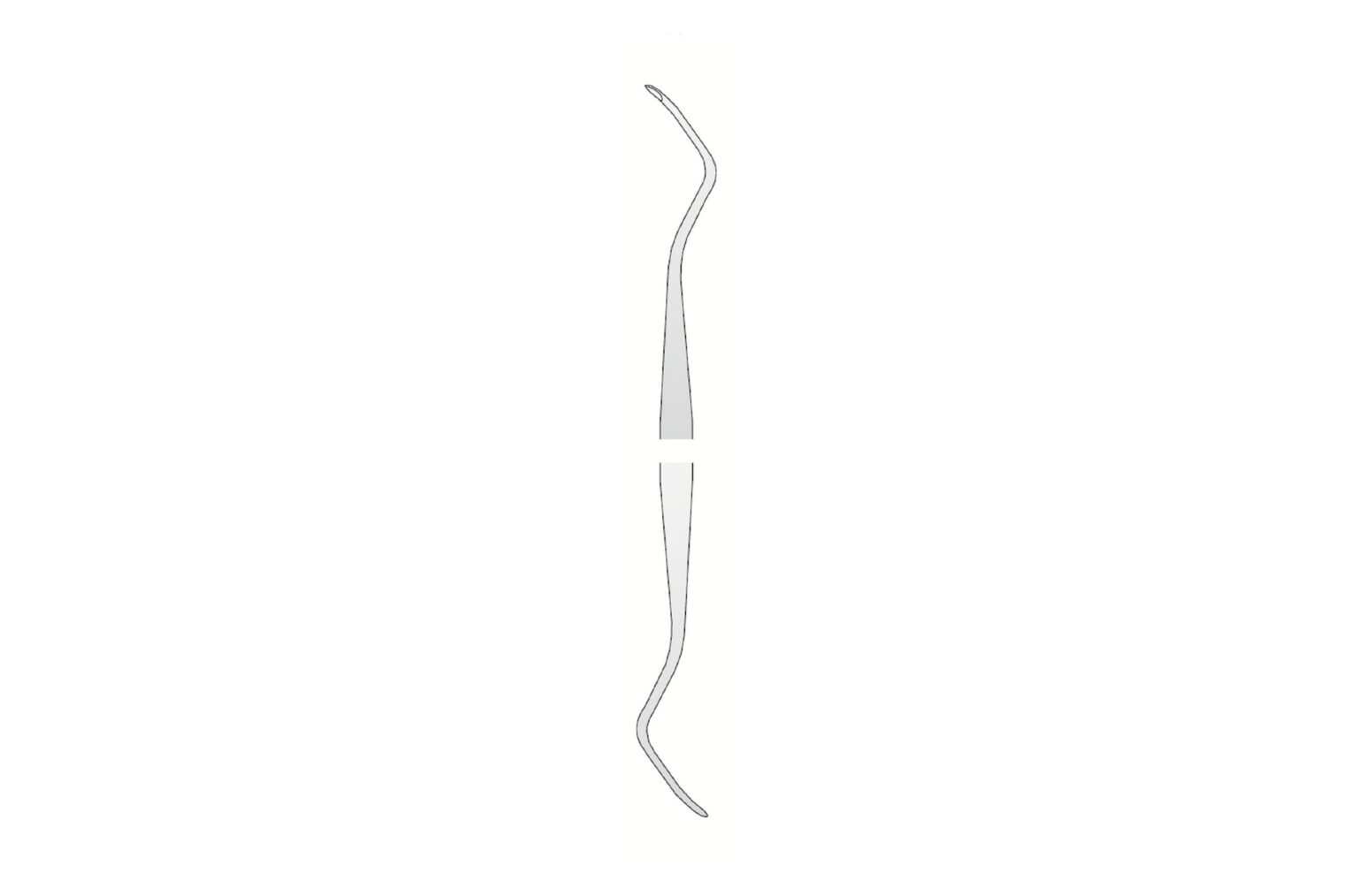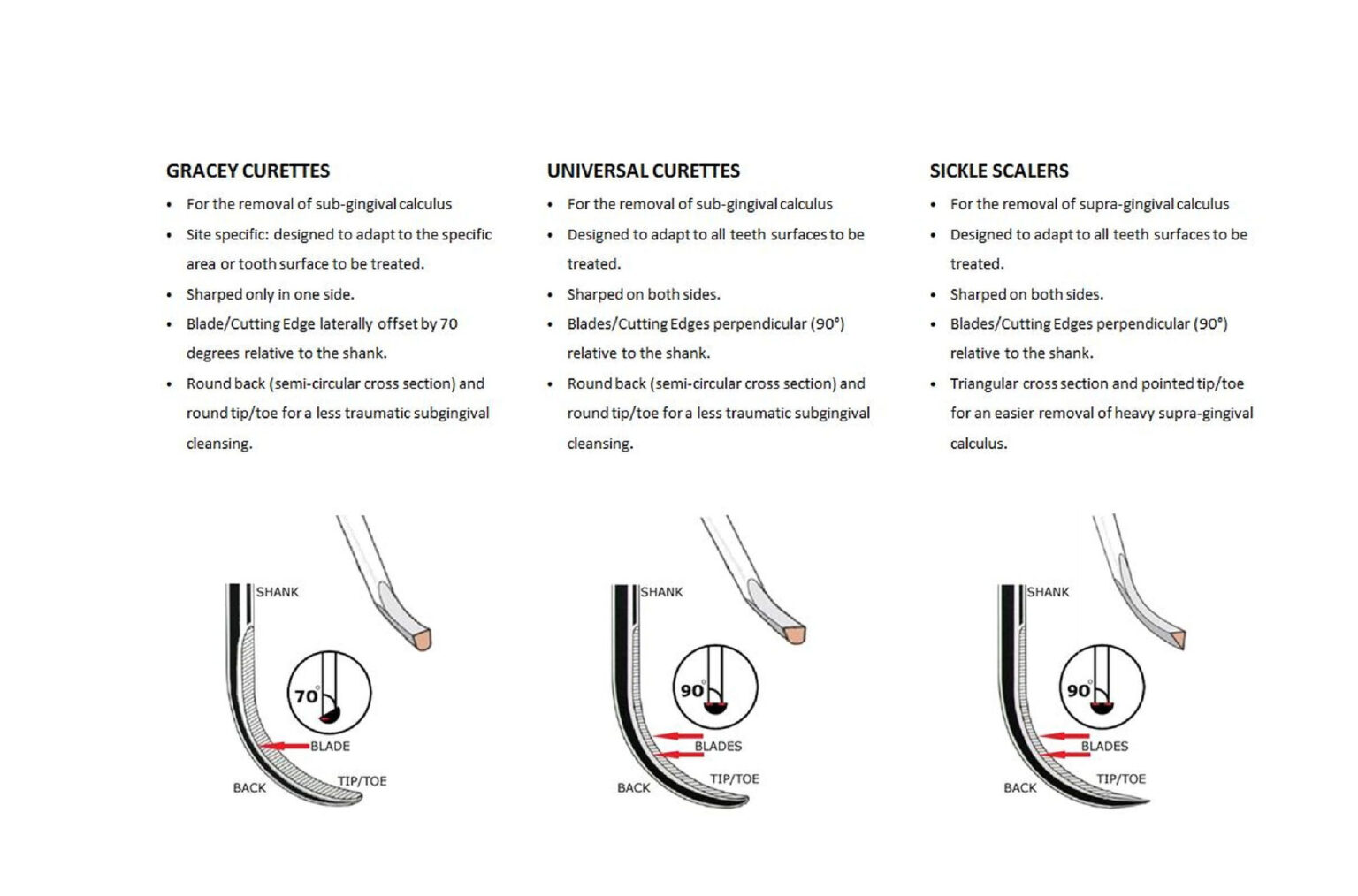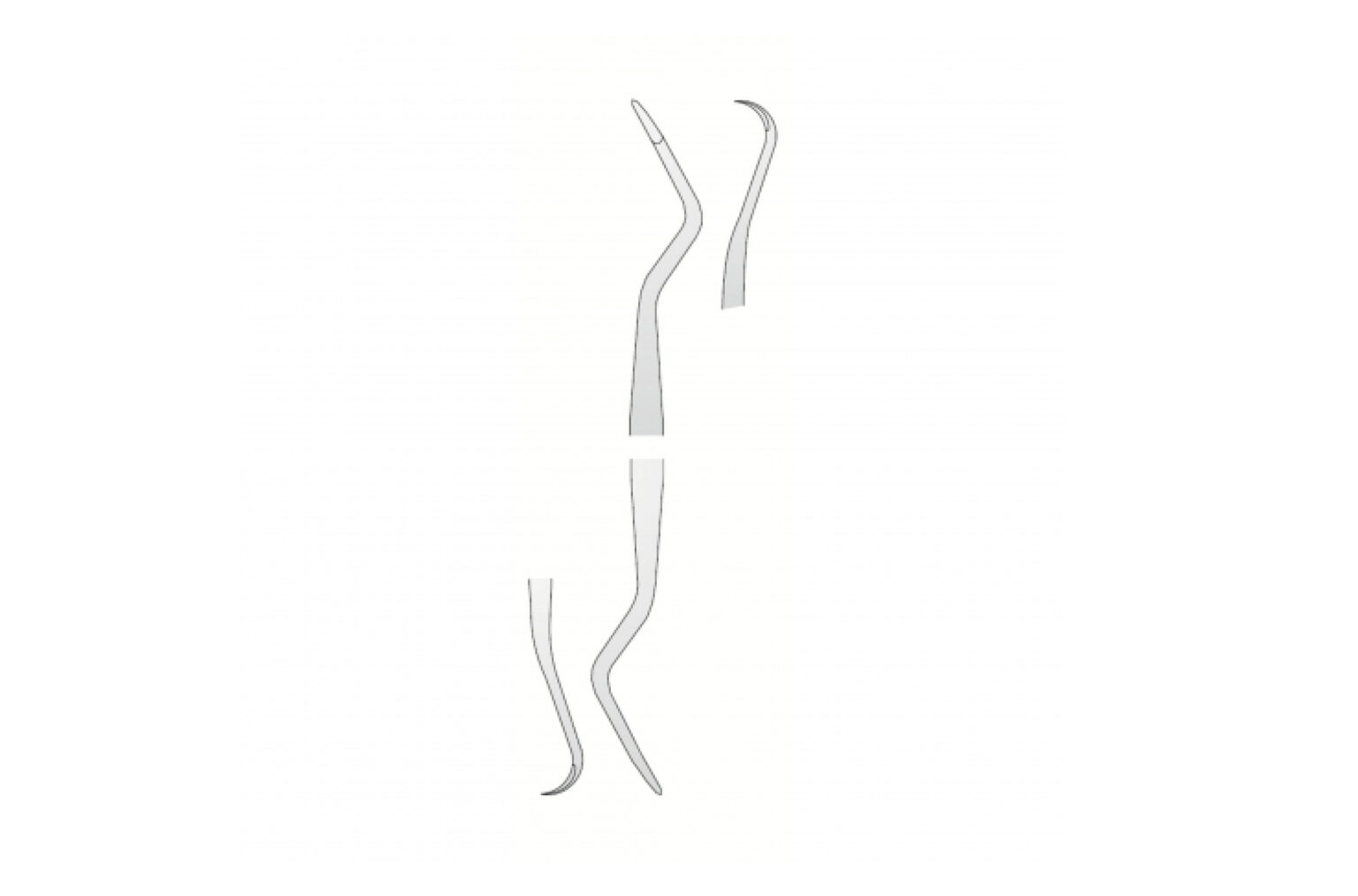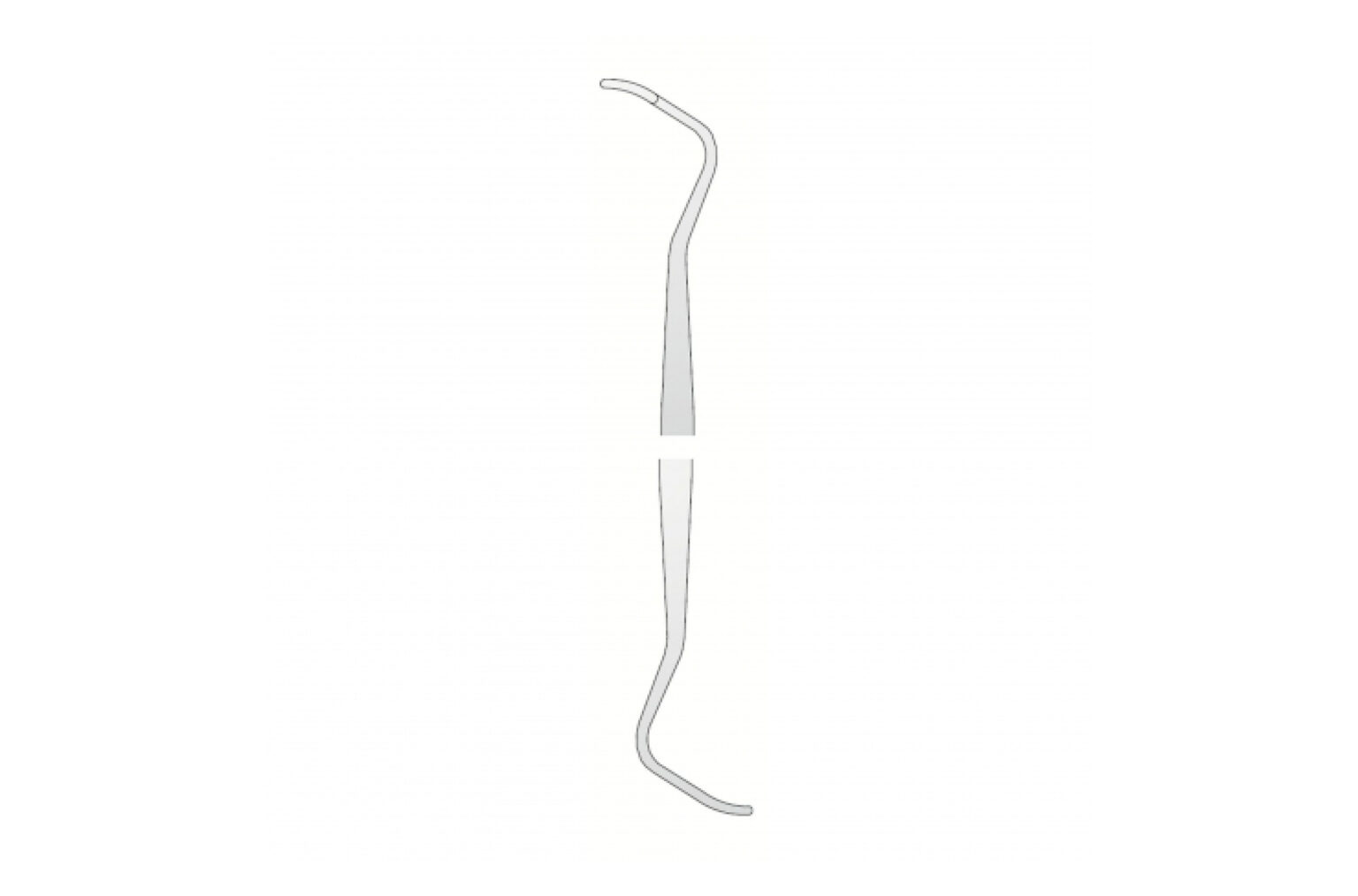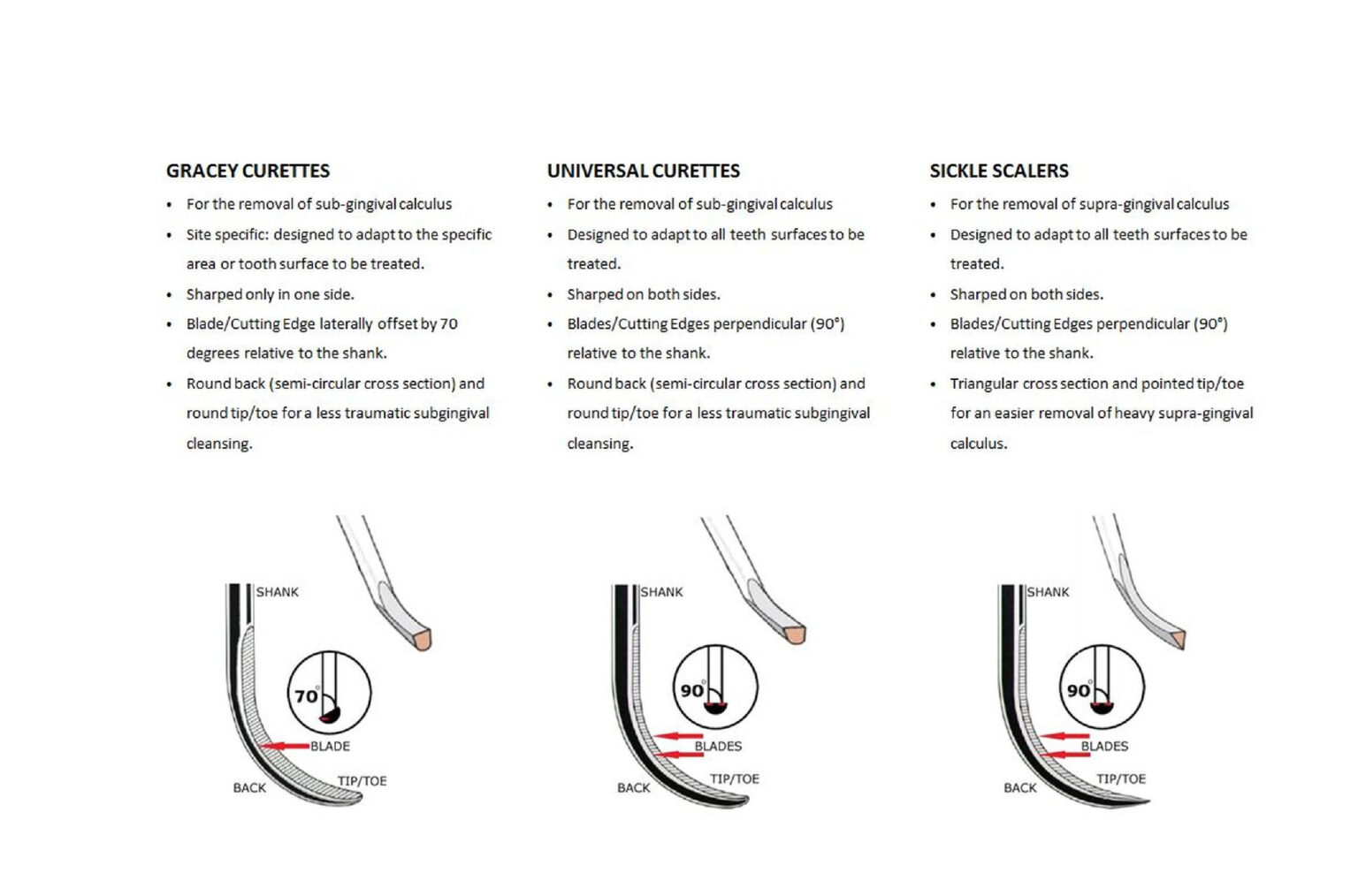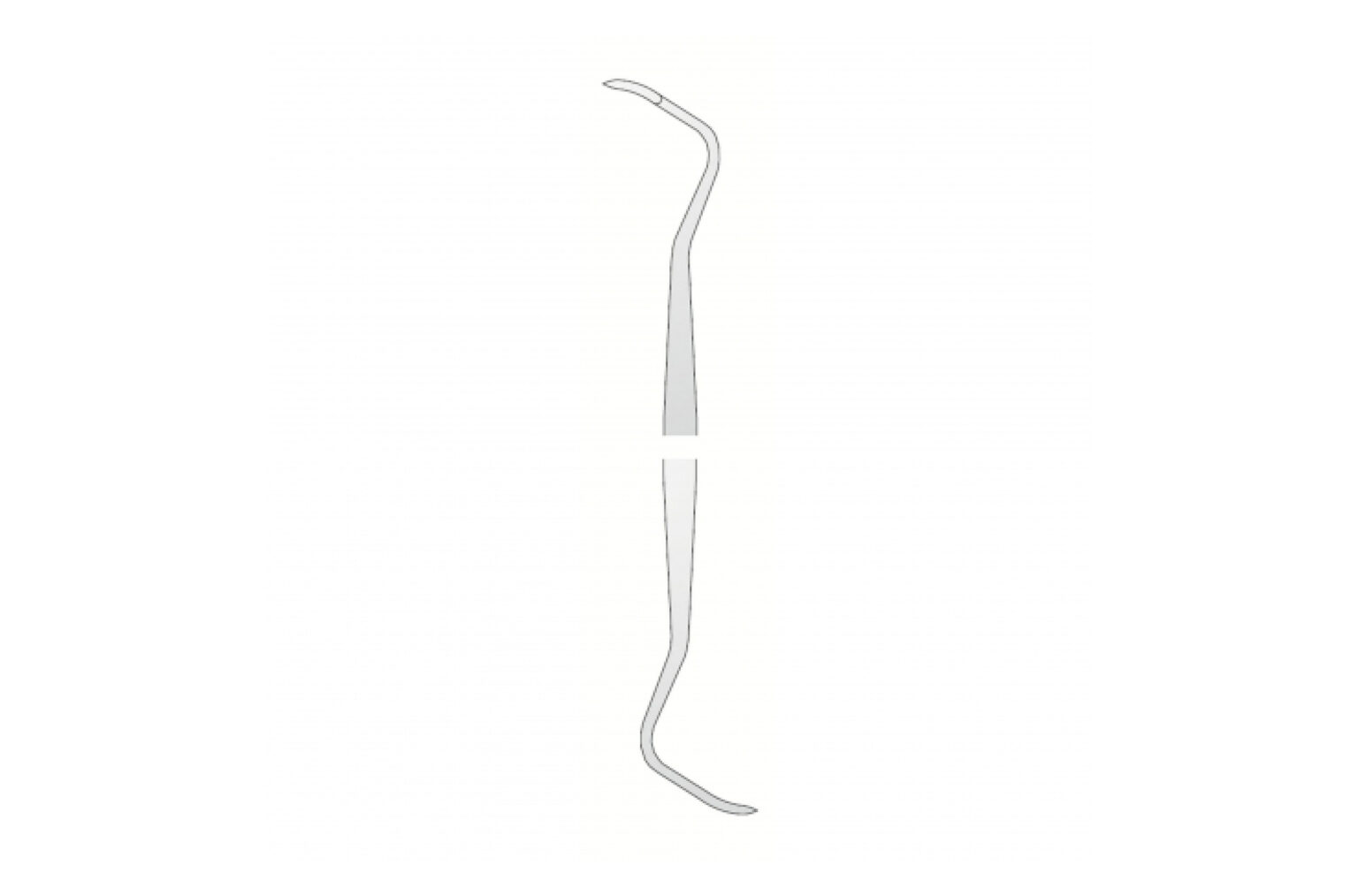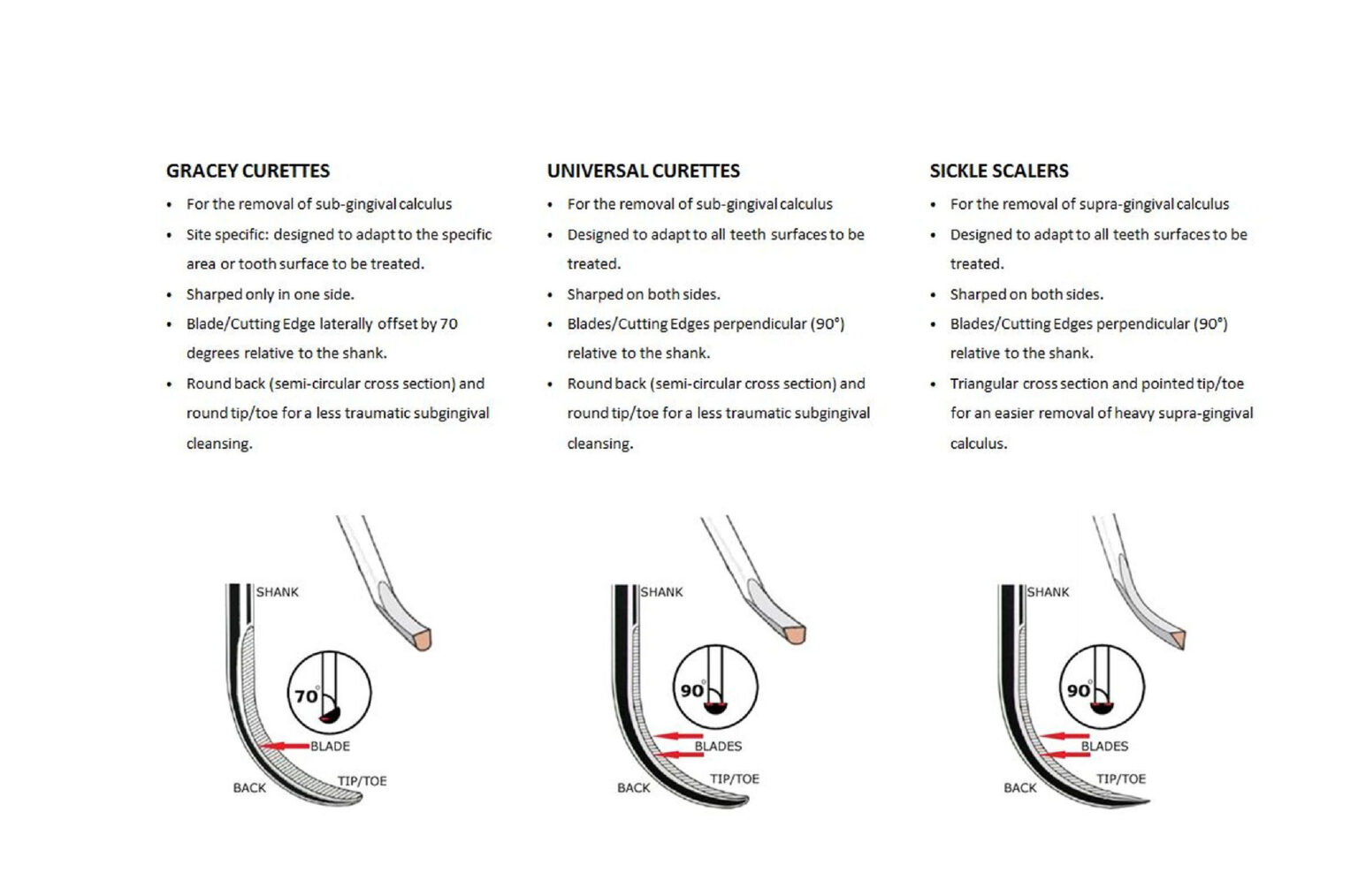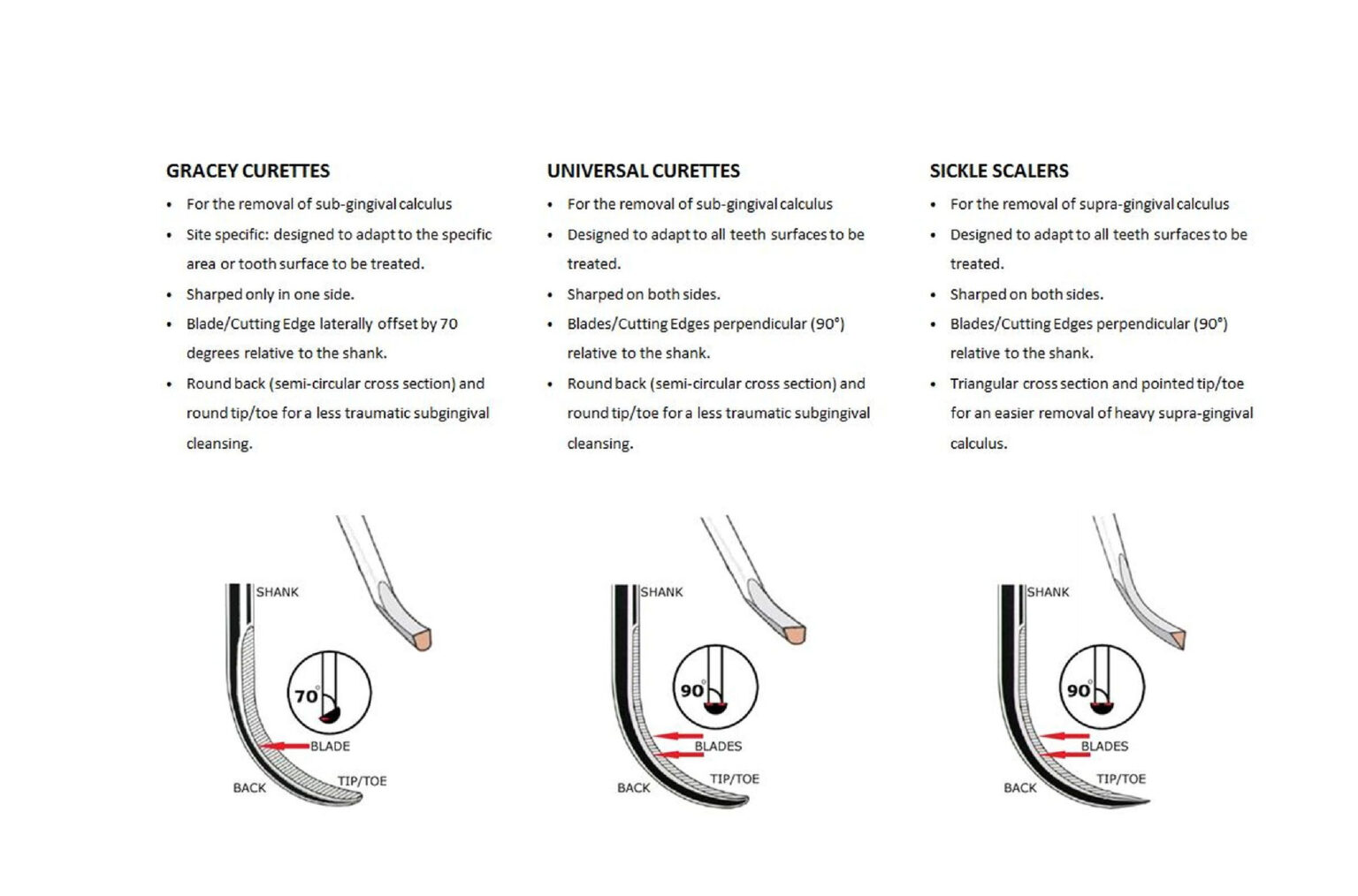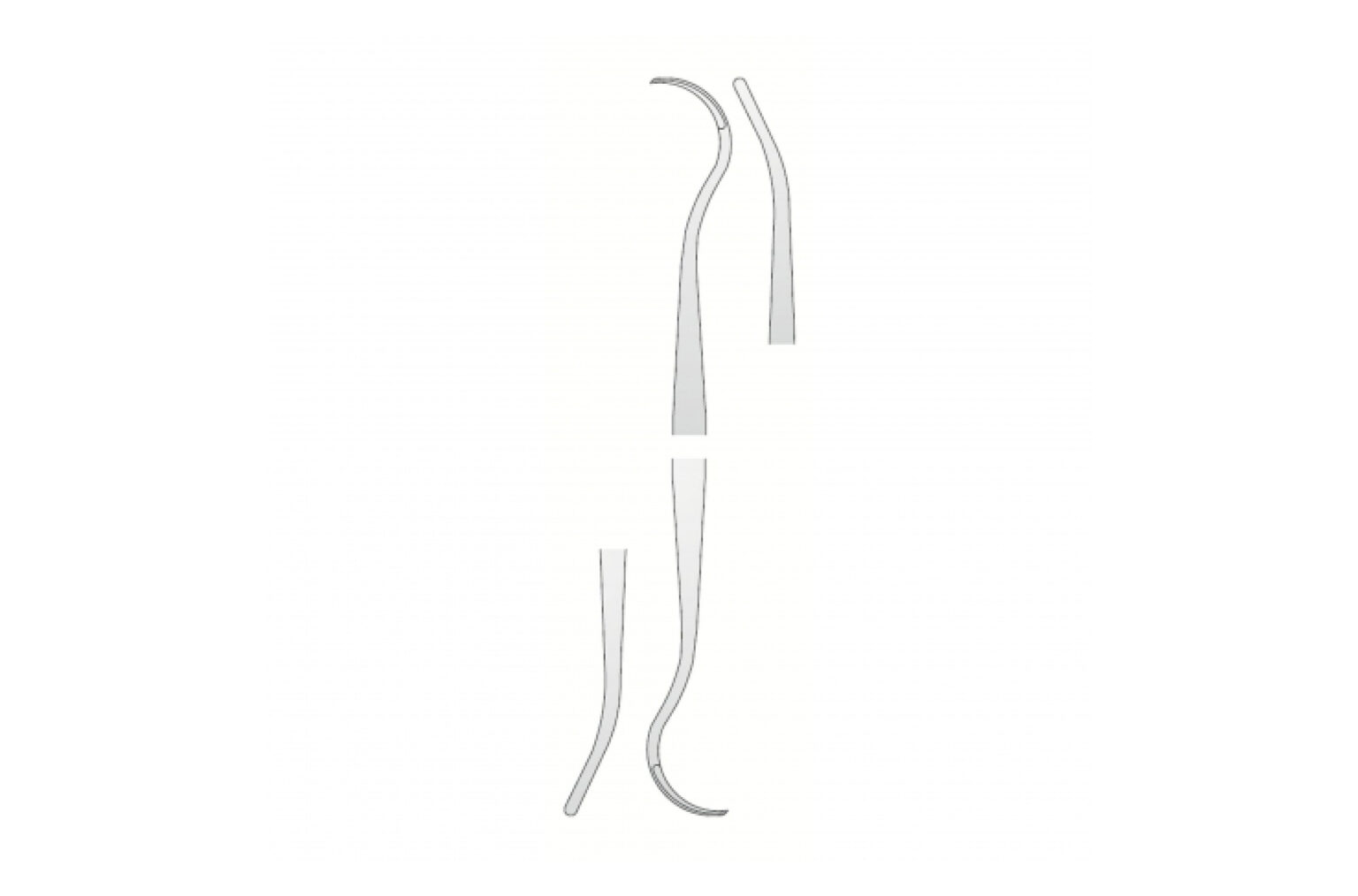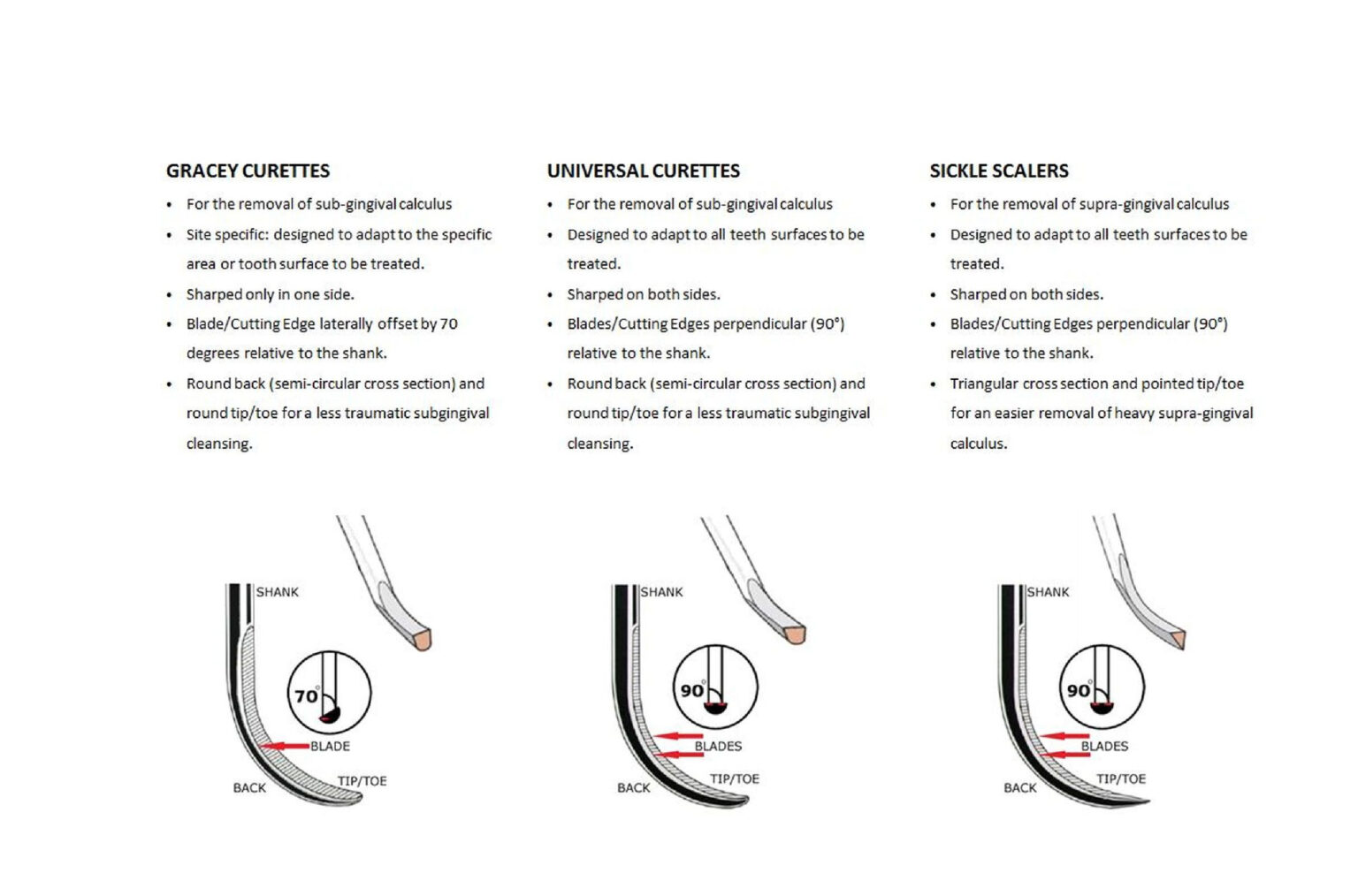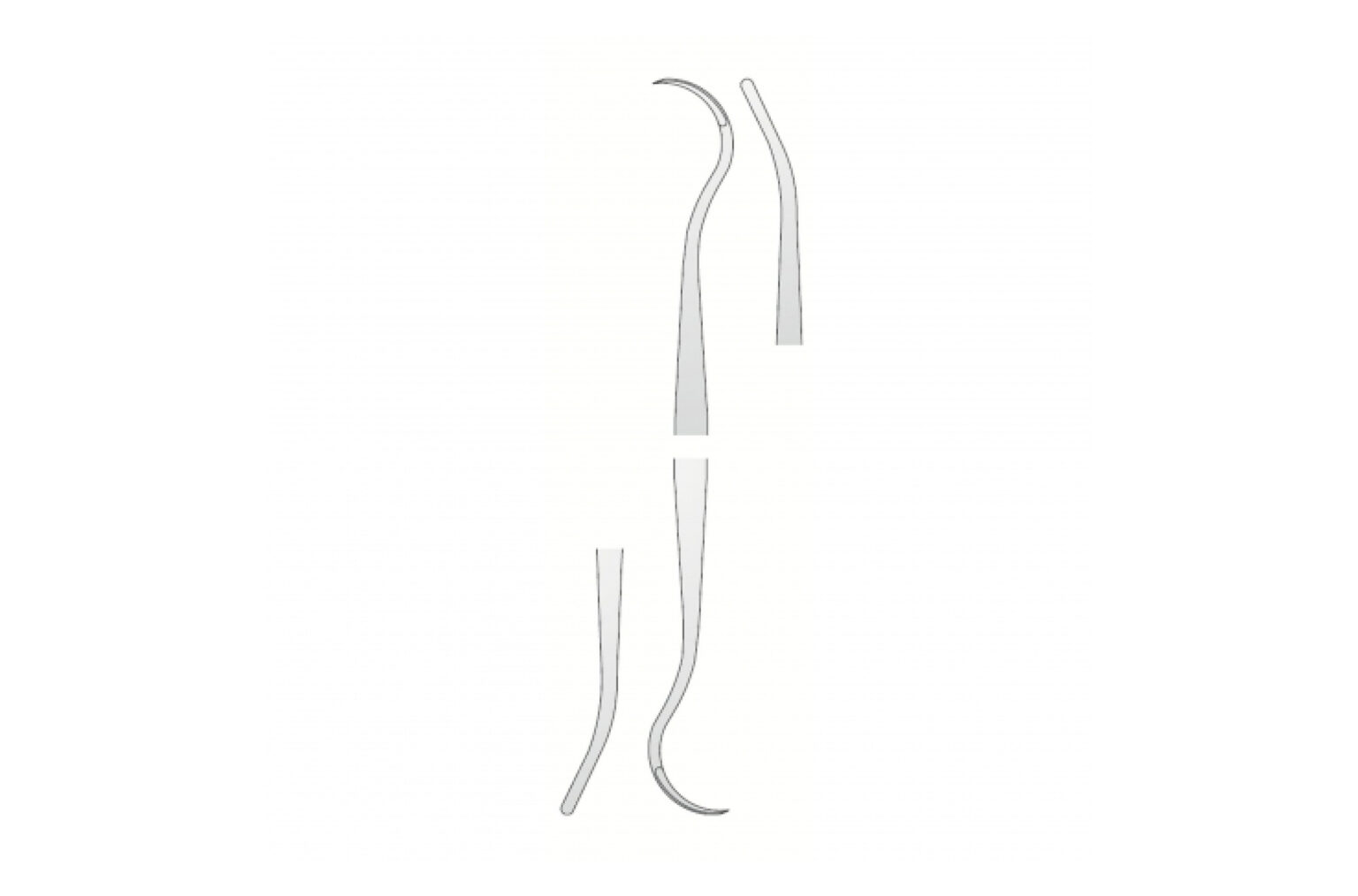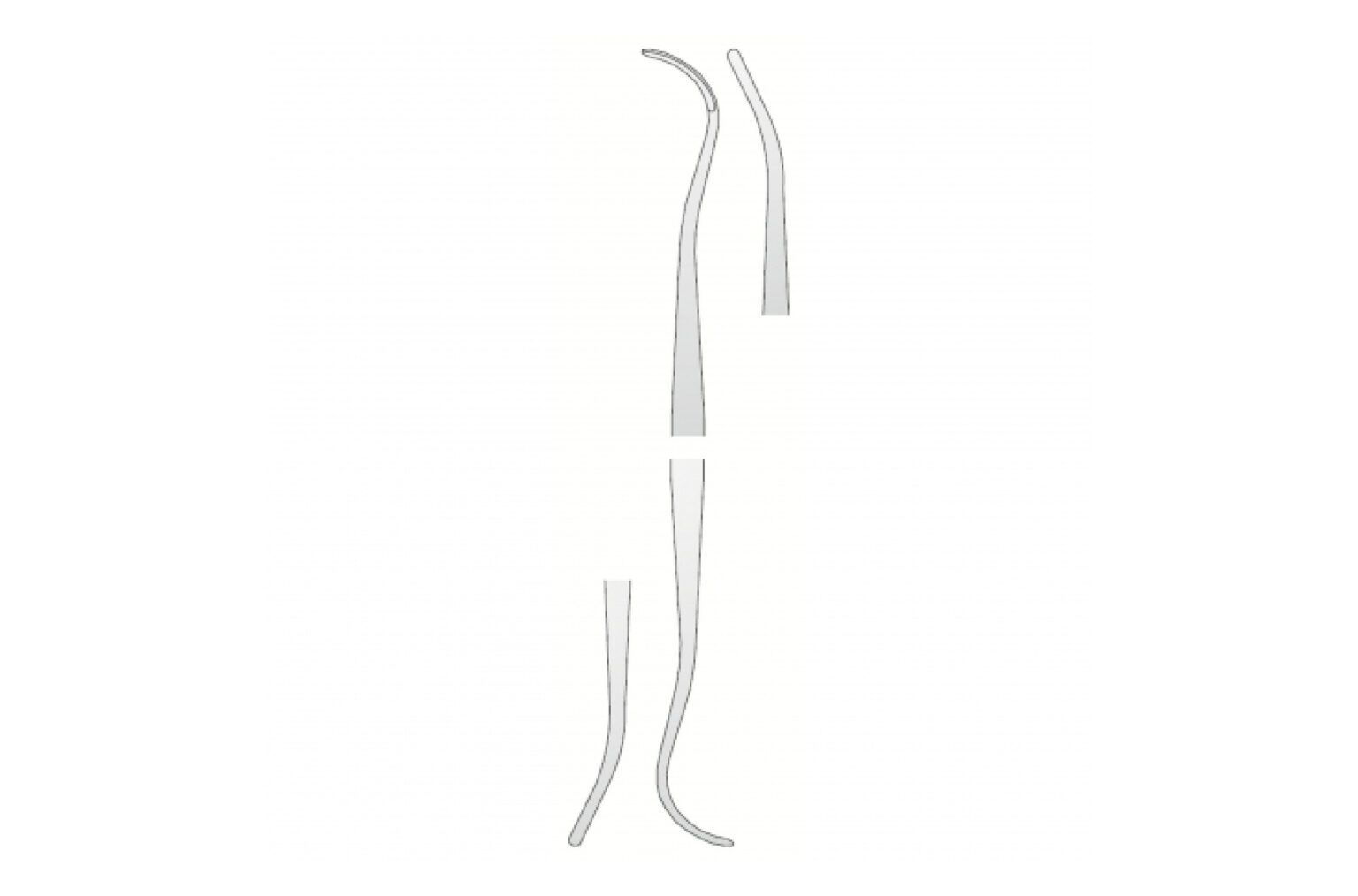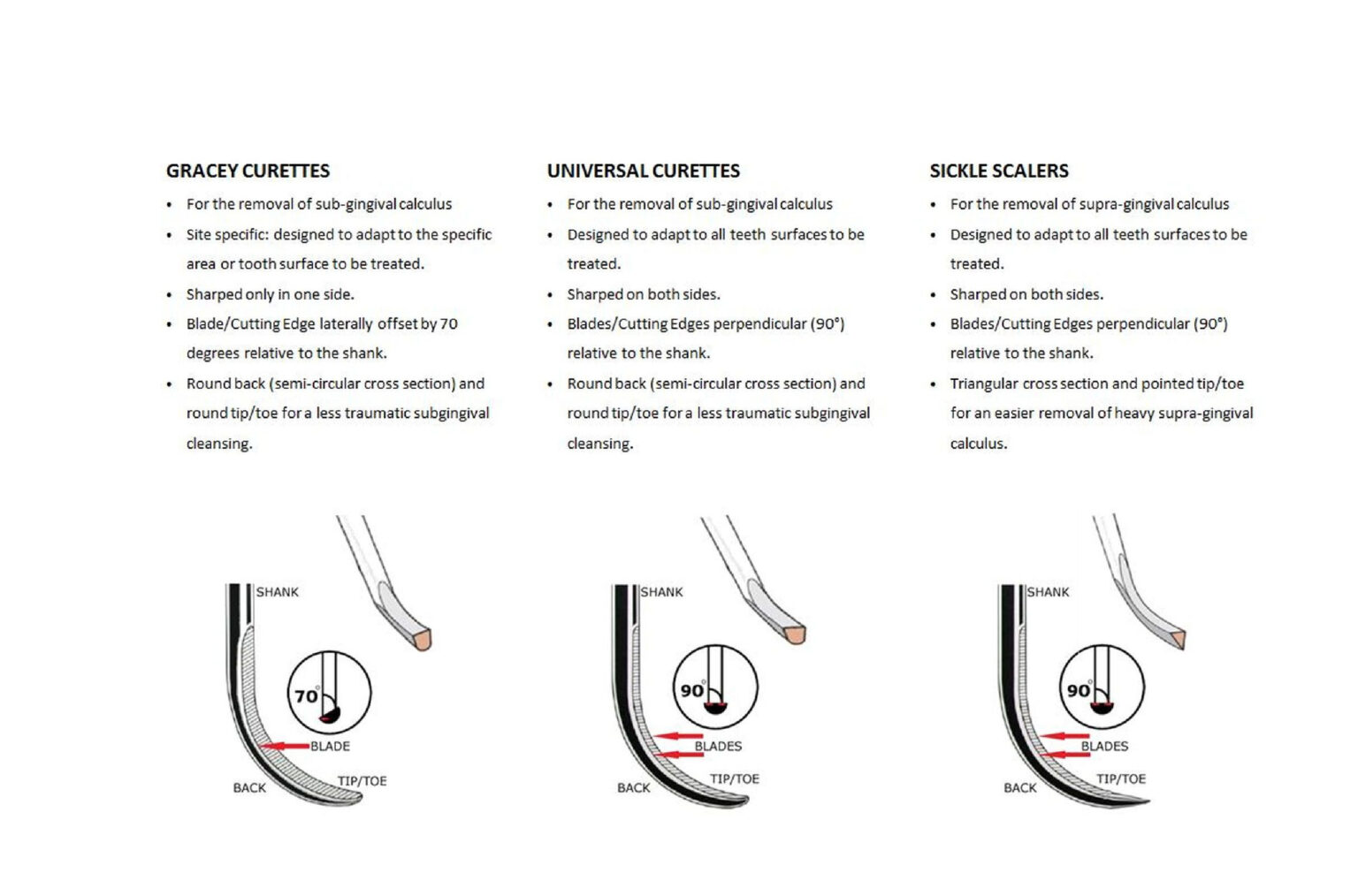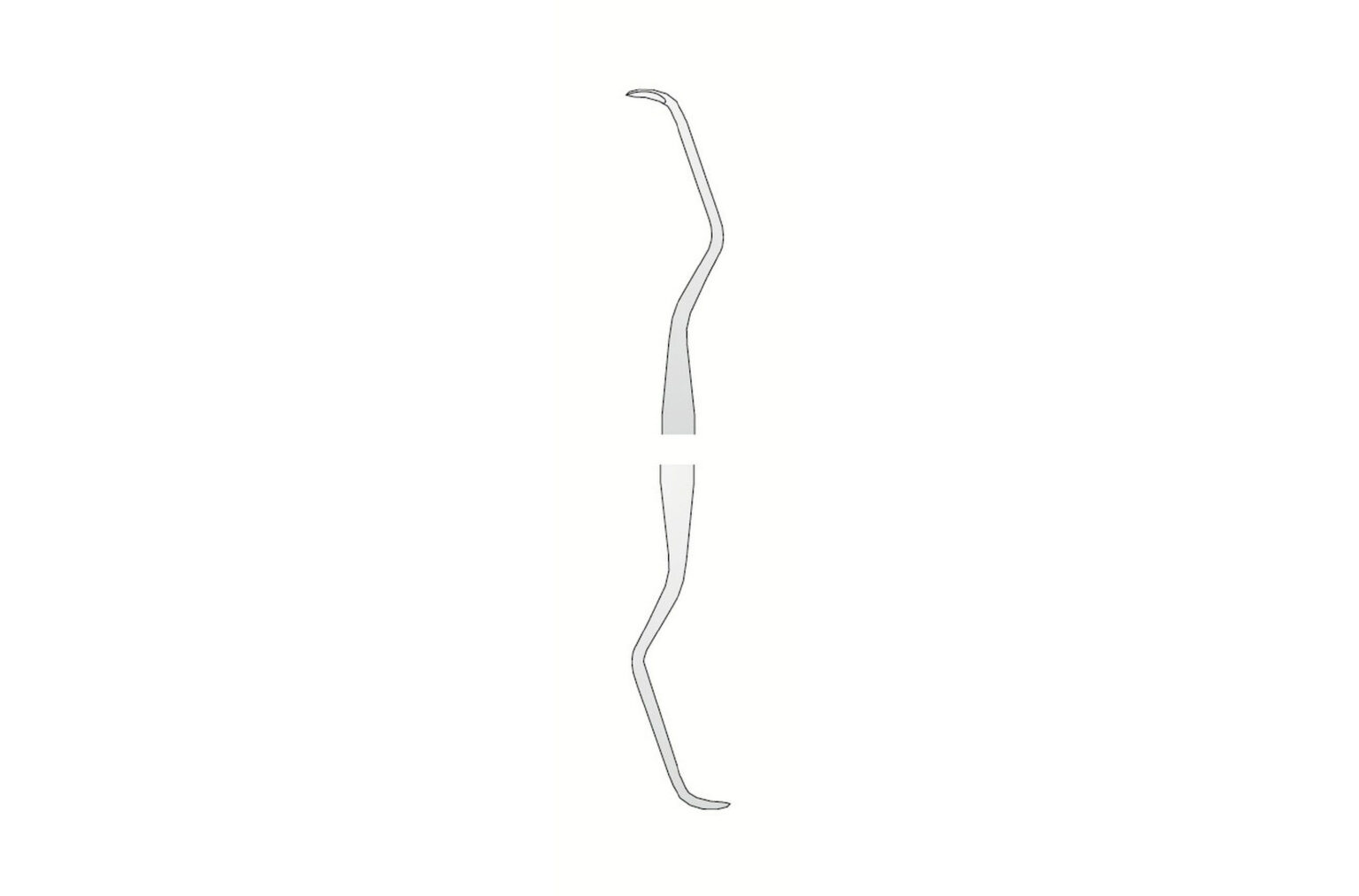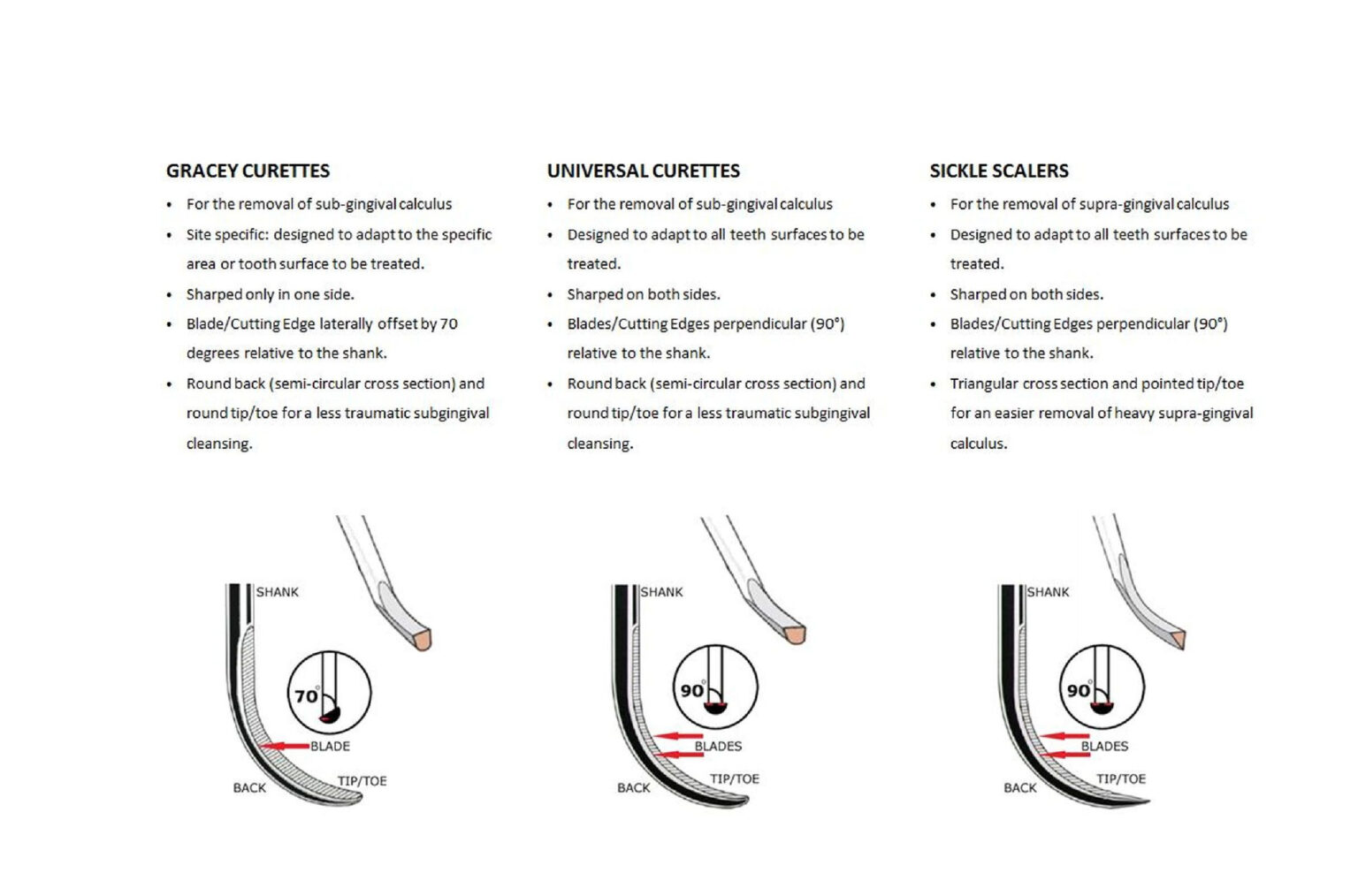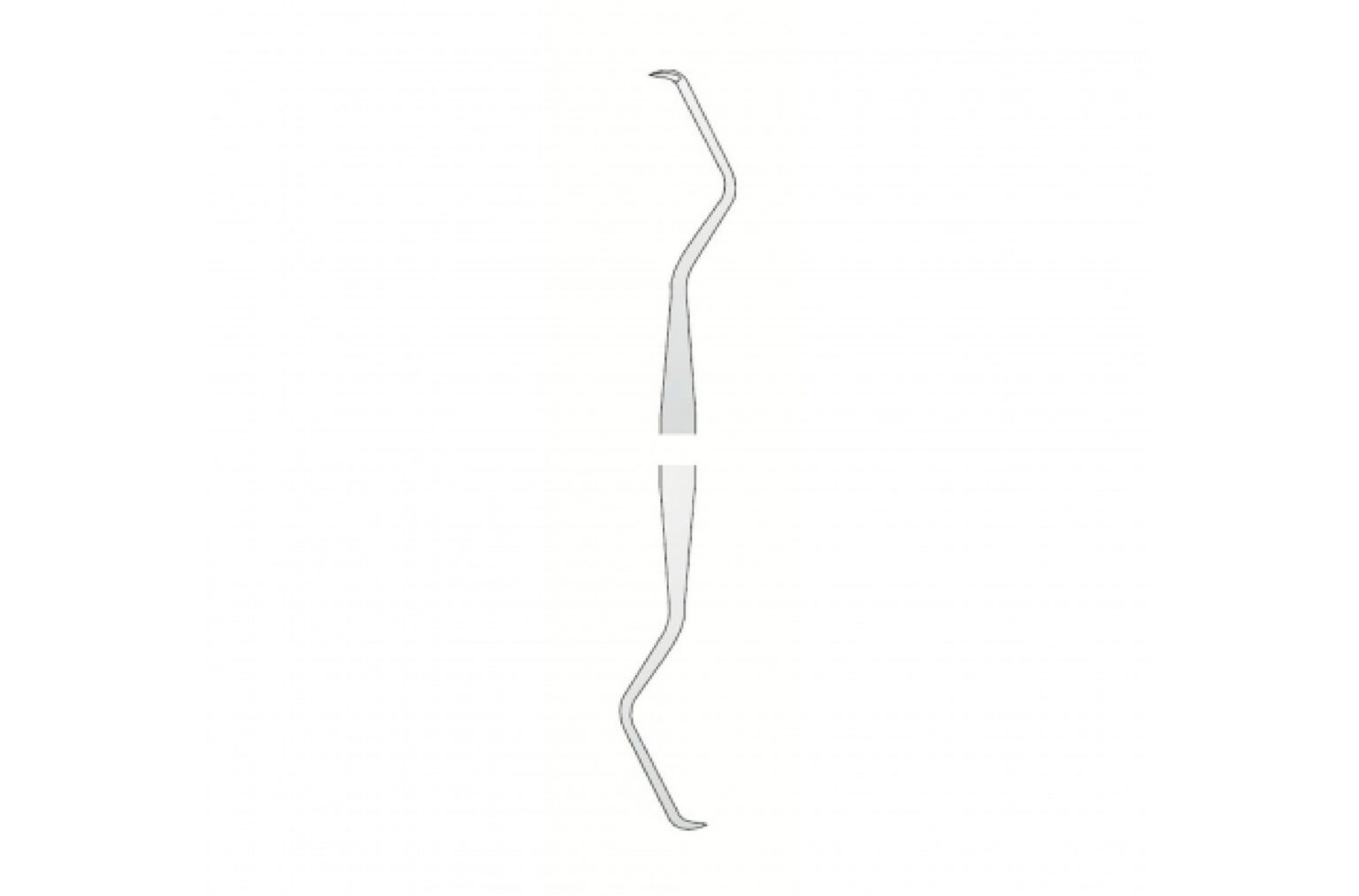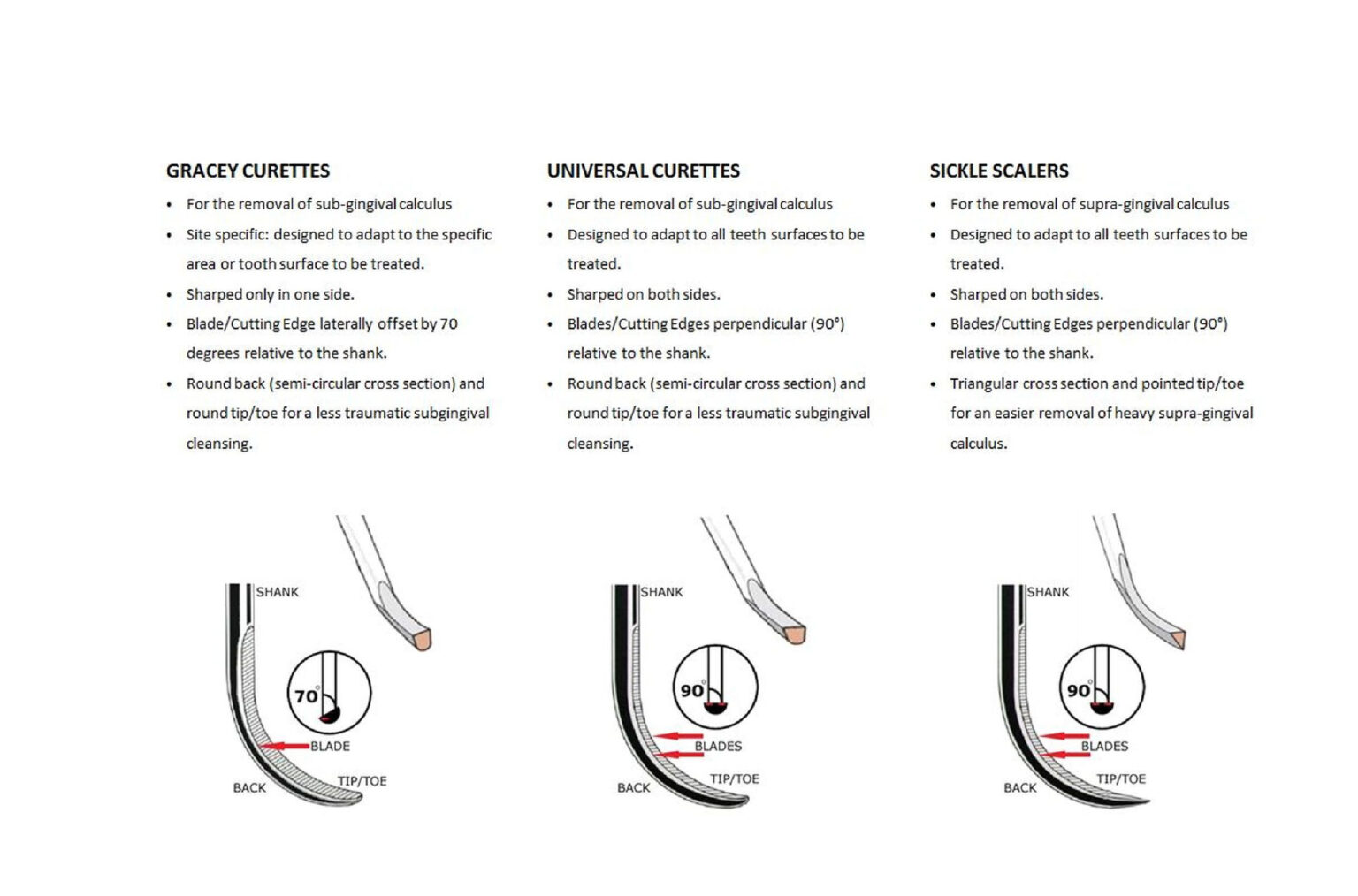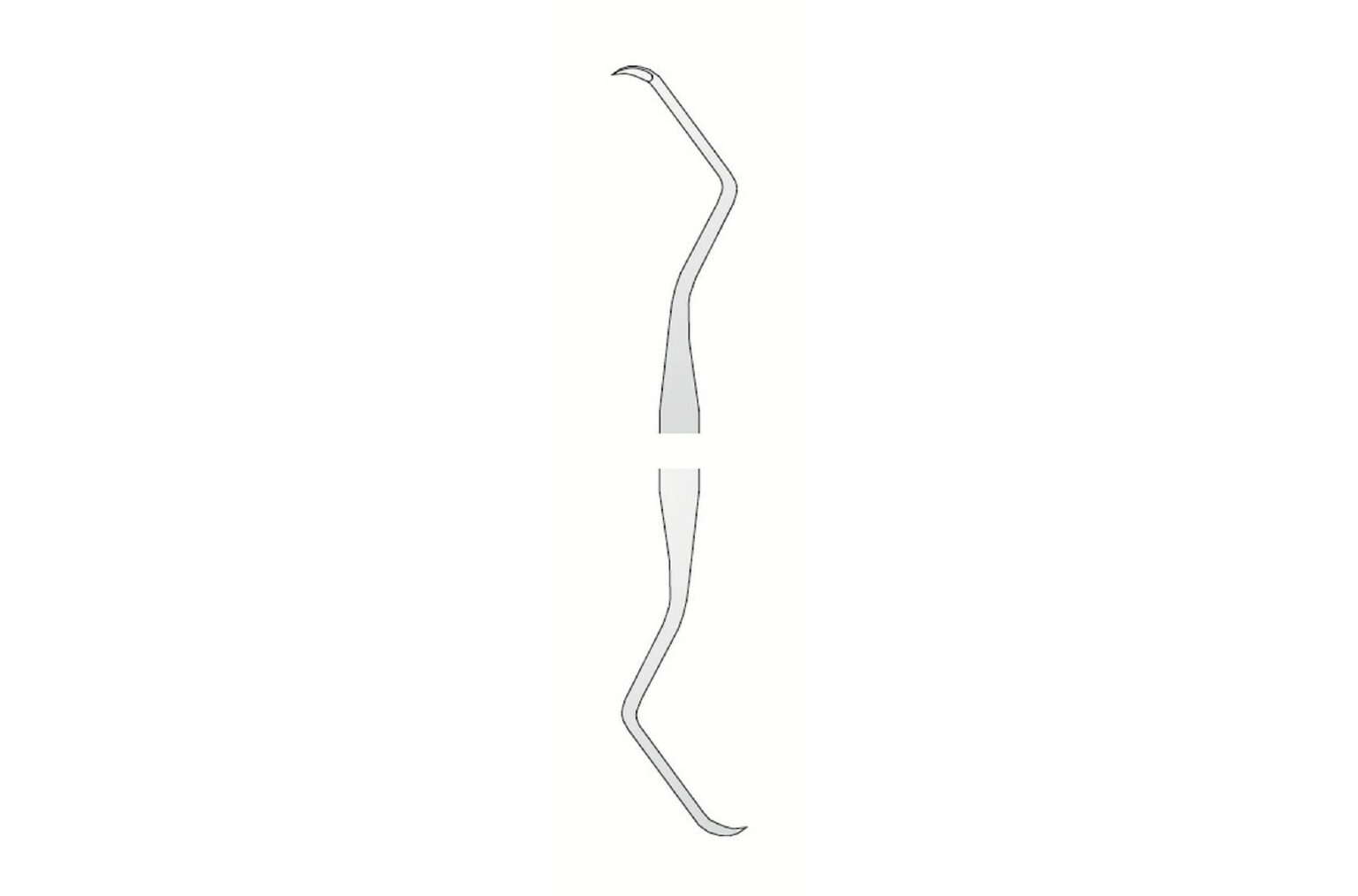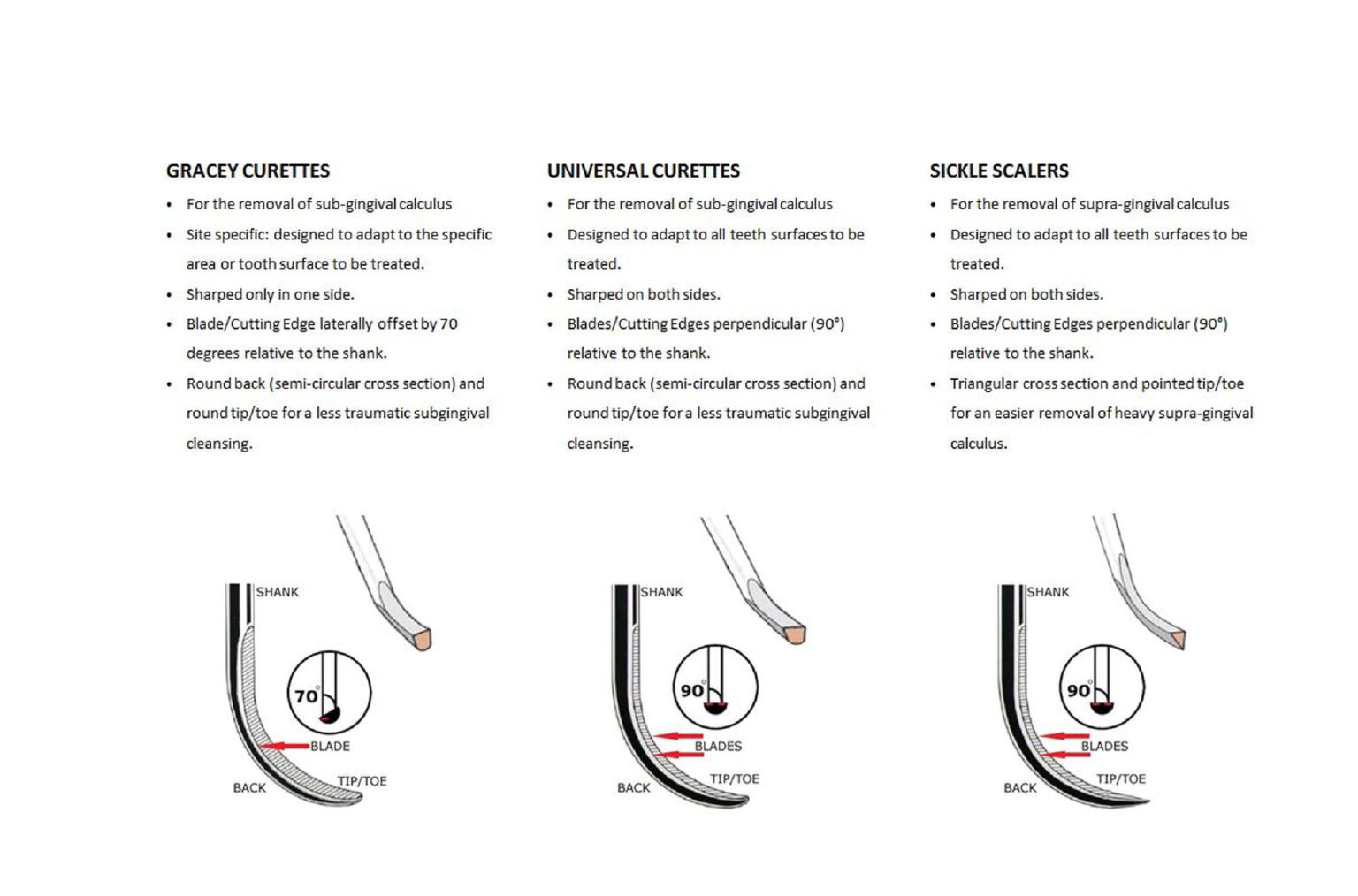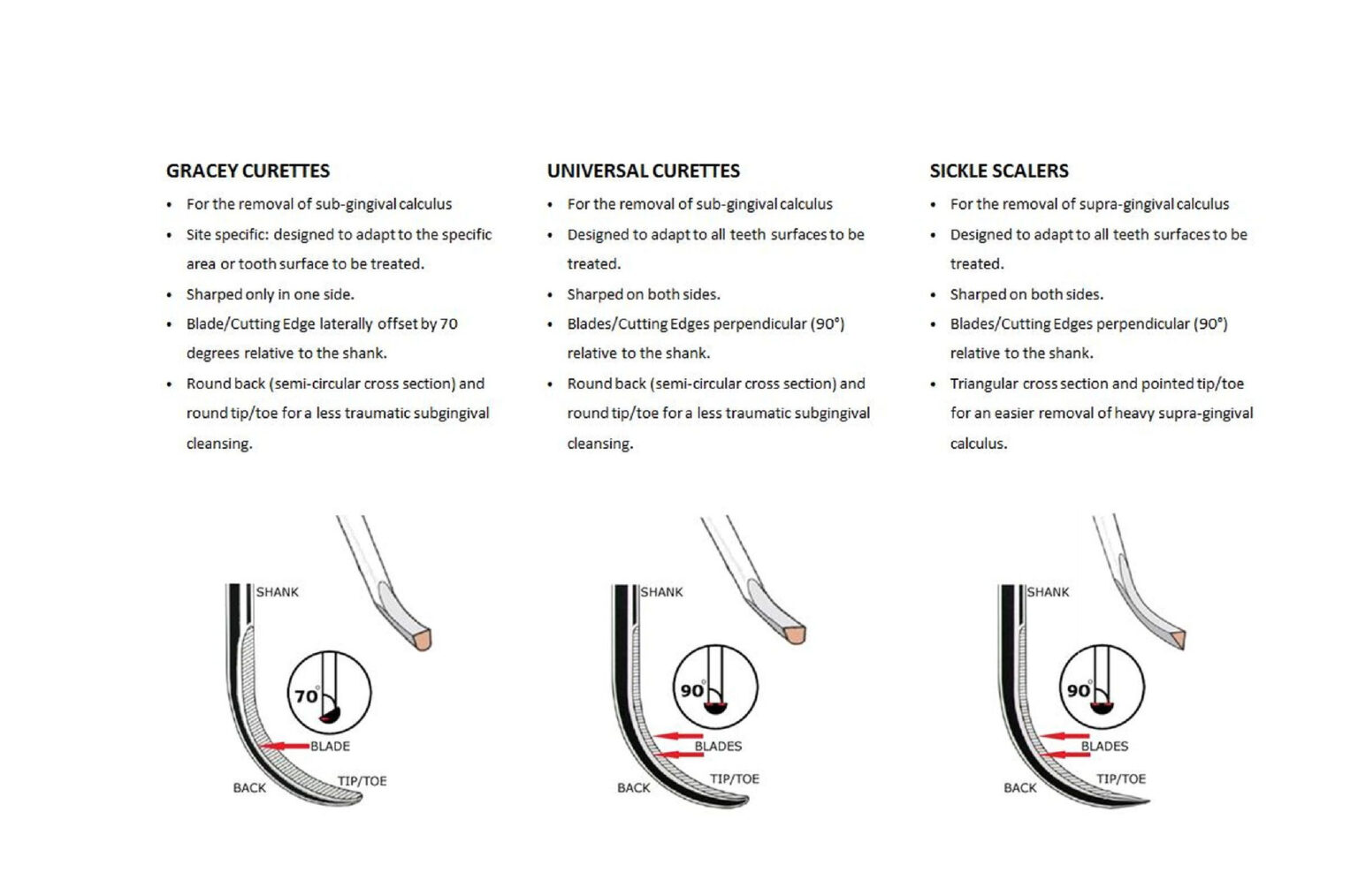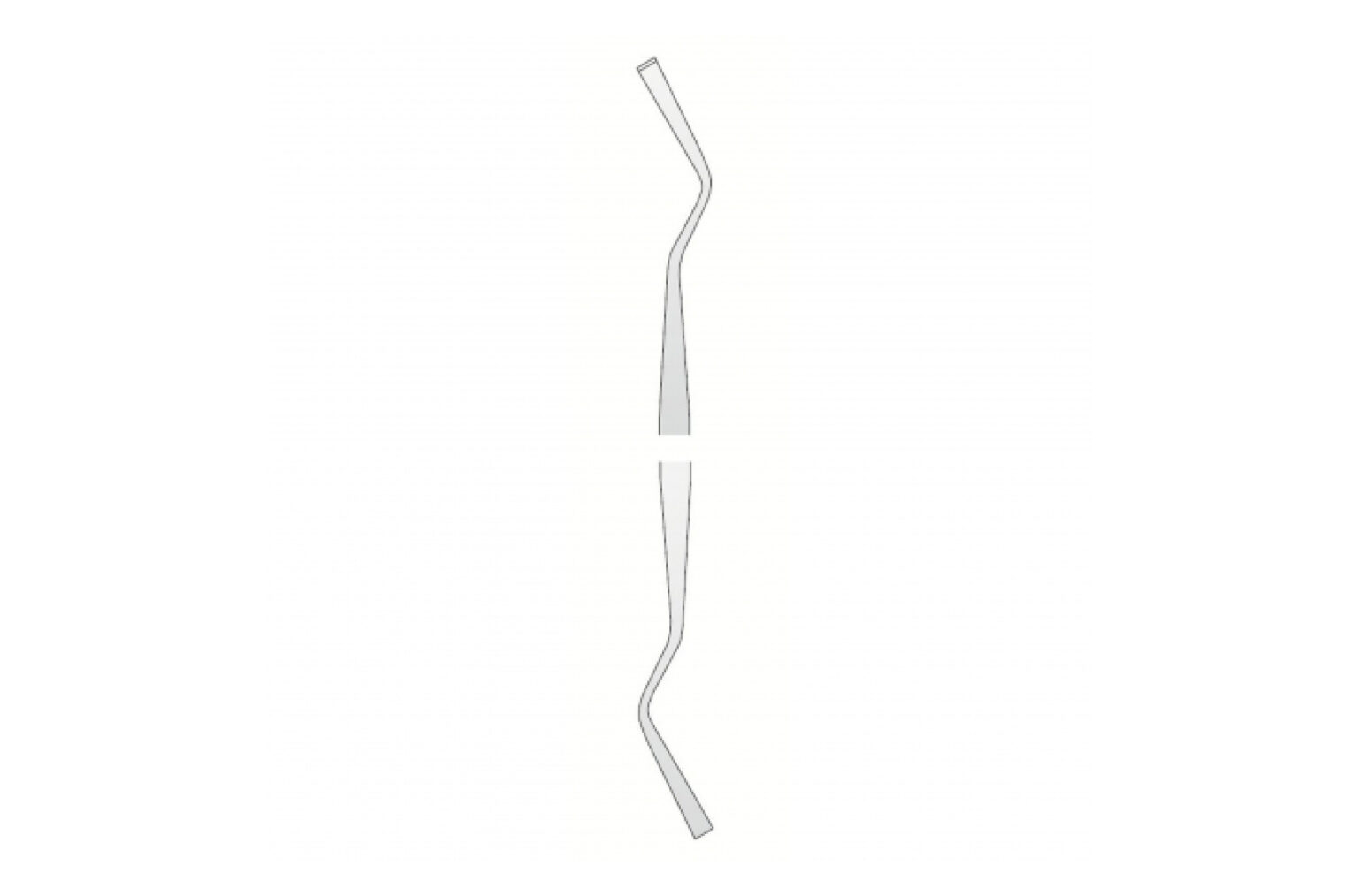CURETTE SWISS TYPE UNIVERSAL
Swiss type (M23)
For the removal of sub-gingival calculus and root cleaning. Universal curettes can be used in any area of the mouth with a semicircular tip used at 90° to the root surface of the tooth. Sharpened on both sides of the blades. Universal
Designed to adapt to all teeth surfaces to be treated. Sharpened on both sides. Blades/Cutting Edges perpendicular (90°) relative to the shank. Round back (semi-circular cross section) and round tip/toe for a less traumatic subgingival cleansing.
Sharpening:
Curettes: curettes have a rounded toe. so the position of the Sharpening Stone is adapted around the rounded cross-section. See more info and details on Sharpening Stone product pages.
Sharpening evaluation:
Visual inspection of the instrument’s cutting edge:
– if the cutting edge is rounded will reflect the light, then it is blunt.
– if the cutting edge is edged will not reflect the light. then it is sharp.
Testing the instrument’s blade with the plastic Testing Stick:
– if it runs smoothly over the Testing Stick, then it is blunt.
– if it grabs into the Testing Stick and removes small fragments of the plastic, then it is sharp.
- Instrument name: Swiss type (M23)
- Tip: Blunt
- Tip Material: Stainless Steel
- Handle: Mod. SMOOTH Ø 8mm – Double-Ended
- Handle Material: Stainless Steel
CURETTE SWISS TYPE
Swiss type
For the removal of sub-gingival calculus and root cleaning. Universal curettes can be used in any area of the mouth with a semicircular tip used at 90° to the root surface of the tooth. Sharpened on both sides of the blades. Designed to adapt to all teeth surfaces to be treated. Sharpened on both sides. Blades/Cutting Edges perpendicular (90°) relative to the shank. Round back (semi-circular cross section) and round tip/toe for a less traumatic subgingival cleansing.
Sharpening:
Curettes: curettes have a rounded toe, so the position of the Sharpening Stone is adapted around the rounded cross-section. See more info and details on Sharpening Stone product pages.
Sharpening evaluation:
Visual inspection of the instrument’s cutting edge:
– if the cutting edge is rounded will reflect the light, then it is blunt.
– if the cutting edge is edged will not reflect the light, then it is sharp.
Testing the instruments blade with the plastic Testing Stick:
– if it runs smoothly over the Testing Stick, then it is blunt.
– if it grabs into the Testing Stick and removes small fragments of the plastic, then it is sharp.
- Instrument name: Swiss type
- Tip: Blunt
- Tip Material: Stainless Steel
- Handle: Mod. SMOOTH Ø 8mm – Double-Ended
- Handle Material: Stainless Steel
CURETTE LANGER 1/2
Langer 1/2
For the removal of sub-gingival calculus and root cleaning. Universal curettes can be used in any area of the mouth with a semicircular tip used at 90° to the root surface of the tooth. Sharpened on both sides of the blades. Mandibular posteriors Designed to adapt to all teeth surfaces to be treated. Sharpened on both sides. Blades/Cutting Edges perpendicular (90°) relative to the shank. Round back (semi-circular cross section) and round tip/toe for a less traumatic subgingival cleansing. LANGER 1/2 = GRACEY 11/12: Shank design of the standard Gracey curettes combined with 90° universal blade (rather than 70° offset blade of the Gracey curette): area specific shank and universal curette blade.
Sharpening:
Curettes: curettes have a rounded toe, so the position of the Sharpening Stone is adapted around the rounded cross-section. See more info and details on Sharpening Stone product pages.
Sharpening evaluation:
Visual inspection of the instrument’s cutting edge:
– if the cutting edge is rounded will reflect the light, then it is blunt.
– if the cutting edge is edged will not reflect the light, then it is sharp.
Testing the instruments blade with the plastic Testing Stick:
– if it runs smoothly over the Testing Stick, then it is blunt.
– if it grabs into the Testing Stick and removes small fragments of the plastic. then it is sharp.
- Instrument name: Langer 1/2
- Tip: Blunt
- Tip Material: Stainless Steel
- Handle: Mod. SMOOTH Ø 8mm – Double-Ended
- Handle Material: Stainless Steel
CURETTE LANGER 3/4
Langer 3/4
For the removal of sub-gingival calculus and root cleaning. Universal curettes can be used in any area of the mouth with a semicircular tip used at 90° to the root surface of the tooth. Sharpened on both sides of the blades. Maxillary posteriors Designed to adapt to all teeth surfaces to be treated. Sharpened on both sides. Blades/Cutting Edges perpendicular (90°) relative to the shank. Round back (semi-circular cross section) and round tip/toe for a less traumatic subgingival cleansing. LANGER 3/4 = GRACEY 13/14: Shank design of the standard Gracey curettes combined with 90° universal blade (rather than 70° offset blade of the Gracey curette): area specific shank and universal curette blade.
Sharpening:
Curettes: curettes have a rounded toe, so the position of the Sharpening Stone is adapted around the rounded cross-section. See more info and details on Sharpening Stone product pages.
Sharpening evaluation:
Visual inspection of the instrument’s cutting edge:
– if the cutting edge is rounded will reflect the light, then it is blunt.
– if the cutting edge is edged will not reflect the light, then it is sharp.
Testing the instruments blade with the plastic Testing Stick:
– if it runs smoothly over the Testing Stick, then it is blunt.
– if it grabs into the Testing Stick and removes small fragments of the plastic. then it is sharp.
- Instrument name: Langer 3/4
- Tip: Blunt
- Tip Material: Stainless Steel
- Handle: Mod. SMOOTH Ø 8mm – Double-Ended
- Handle Material: Stainless Steel
CURETTE LANGER 5/6
Langer 5/6
For the removal of sub-gingival calculus and root cleaning. Universal curettes can be used in any area of the mouth with a semicircular tip used at 90° to the root surface of the tooth. Sharpened on both sides of the blades. Mandibular and maxillary anteriors Designed to adapt to all teeth surfaces to be treated. Sharpened on both sides. Blades/Cutting Edges perpendicular (90°) relative to the shank. Round back (semi-circular cross section) and round tip/toe for a less traumatic subgingival cleansing. LANGER 5/6 = GRACE( 5/6: Shank design of the standard Gracey curettes combined with 90° universal blade (rather than 70° offset blade of the Gracey curette): area specific shank and universal curette blade.
Sharpening:
Curettes: curettes have a rounded toe, so the position of the Sharpening Stone is adapted around the rounded cross-section. See more info and details on Sharpening Stone product pages.
Sharpening evaluation:
Visual inspection of the instruments cutting edge:
– if the cutting edge is rounded will reflect the light, then it is blunt.
– if the cutting edge is edged will not reflect the light, then it is sharp.
Testing the instruments blade with the plastic Testing Stick:
– if it runs smoothly over the Testing Stick, then it is blunt.
– if it grabs into the Testing Stick and removes small fragments of the plastic. then it is sharp.
- Instrument name: Langer 5/6
- Tip: Blunt
- Tip Material: Stainless Steel
- Handle: Mod. SMOOTH Ø 8mm – Double-Ended
- Handle Material: Stainless Steel
CURETTE COLUMBIA 2R/2L
Columbia 2R/2L
For the removal of sub-gingival calculus and root cleaning. Universal curettes can be used in any area of the mouth with a semicircular tip used at 90° to the root surface of the tooth. Sharpened on both sides of the blades. Anterior. Designed to adapt to all teeth surfaces to be treated. Sharpened on both sides. Blades/Cutting Edges perpendicular (90°) relative to the shank. Round back (semi-circular cross section) and round tip/toe for a less traumatic subgingival cleansing.
Sharpening:
Curettes: curettes have a rounded toe, so the position of the Sharpening Stone is adapted around the rounded cross-section. See more info and details on Sharpening Stone product pages.
Sharpening evaluation:
Visual inspection of the instrument’s cutting edge:
– if the cutting edge is rounded will reflect the light, then it is blunt.
– if the cutting edge is edged will not reflect the light, then it is sharp.
Testing the instruments blade with the plastic Testing Stick:
– if it runs smoothly over the Testing Stick, then it is blunt.
– if it grabs into the Testing Stick and removes small fragments of the plastic. then it is sharp.
- Instrument name: Columbia 2R/2L
- Tip: Blunt
- Tip Material: Stainless Steel
- Handle: Mod. SMOOTH Ø 8mm – Double-Ended
- Handle Material: Stainless Steel
CURETTE COLUMBIA 4R/4L
Columbia 4R/4L
For the removal of sub-gingival calculus and root cleaning. Universal curettes can be used in any area of the mouth with a semicircular tip used at 90° to the root surface of the tooth. Sharpened on both sides of the blades. Posterior
Designed to adapt to all teeth surfaces to be treated. Sharpened on both sides. Blades/Cutting Edges perpendicular (90°) relative to the shank. Round back (semi-circular cross section) and round tip/toe for a less traumatic subgingival cleansing.
Sharpening:
Curettes: curettes have a rounded toe, so the position of the Sharpening Stone is adapted around the rounded cross-section. See more info and details on Sharpening Stone product pages.
Sharpening evaluation:
Visual inspection of the instrument’s cutting edge:
– if the cutting edge is rounded will reflect the light, then it is blunt.
– if the cutting edge is edged will not reflect the light, then it is sharp.
Testing the instruments blade with the plastic Testing Stick:
– if it runs smoothly over the Testing Stick, then it is blunt.
– if it grabs into the Testing Stick and removes small fragments of the plastic. then it is sharp.
- Instrument name: Columbia 4R/4L
- Tip: Blunt
- Tip Material: Stainless Steel
- Handle: Mod. SMOOTH Ø 8mm – Double-Ended
- Handle Material: Stainless Steel
CURETTE COLUMBIA 13/14
Columbia 13/14
For the removal of sub-gingival calculus and root cleaning. Universal curettes can be used in any area of the mouth with a semicircular tip used at 90° to the root surface of the tooth. Sharpened on both sides of the blades. Universal
Designed to adapt to all teeth surfaces to be treated. Sharpened on both sides. Blades/Cutting Edges perpendicular (90°) relative to the shank. Round back (semi-circular cross section) and round tip/toe for a less traumatic subgingival cleansing.
Sharpening:
Curettes: curettes have a rounded toe, so the position of the Sharpening Stone is adapted around the rounded cross-section. See more info and details on Sharpening Stone product pages.
Sharpening evaluation:
Visual inspection of the instrument’s cutting edge:
– if the cutting edge is rounded will reflect the light, then it is blunt.
– if the cutting edge is edged will not reflect the light, then it is sharp. Testing the instruments blade with the plastic Testing Stick: – if it runs smoothly over the Testing Stick, then it is blunt.
– if it grabs into the Testing Stick and removes small fragments of the plastic, then it is sharp.
- Instrument name: Columbia 13/14
- Tip: Blunt
- Tip Material: Stainless Steel
- Handle: Mod. SMOOTH Ø 8mm – Double-Ended
- Handle Material: Stainless Steel
CURETTE MCCALL 11/12
McCall 11/12
For the removal of sub-gingival calculus and root cleaning. Universal curettes can be used in any area of the mouth with a semicircular tip used at 90° to the root surface of the tooth. Sharpened on both sides of the blades. Designed to adapt to all teeth surfaces to be treated. Sharpened on both sides. Blades/Cutting Edges perpendicular (90°) relative to the shank. Round back (semi-circular cross section) and round tip/toe for a less traumatic subgingival cleansing.
Sharpening:
Curettes: curettes have a rounded toe, so the position of the Sharpening Stone is adapted around the rounded cross-section. See more info and details on Sharpening Stone product pages.
Sharpening evaluation:
Visual inspection of the instrument’s cutting edge:
– if the cutting edge is rounded will reflect the light, then it is blunt.
– if the cutting edge is edged will not reflect the light, then it is sharp.
Testing the instrument’s blade with the plastic Testing Stick:
– if it runs smoothly over the Testing Stick, then it is blunt.
– if it grabs into the Testing Stick and removes small fragments of the plastic. then it is sharp.
- Instrument name: McCall 11/12
- Tip: Pointed
- Tip Material: Stainless Steel
- Handle: Mod. SMOOTH Ø 8mm – Double-Ended
- Handle Material: Stainless Steel
CURETTE MCCALL 11A/12A
McCall 11A/12A
For the removal of sub-gingival calculus and root cleaning. Universal curettes can be used in any area of the mouth with a semicircular tip used at 90° to the root surface of the tooth. Sharpened on both sides of the blades. Designed to adapt to all teeth surfaces to be treated. Sharpened on both sides. Blades/Cutting Edges perpendicular (90°) relative to the shank. Round back (semi-circular cross section) and round tip/toe for a less traumatic subgingival cleansing.
Sharpening:
Curettes: curettes have a rounded toe, so the position of the Sharpening Stone is adapted around the rounded cross-section. See more info and details on Sharpening Stone product pages.
Sharpening evaluation:
Visual inspection of the instrument’s cutting edge:
– if the cutting edge is rounded will reflect the light, then it is blunt.
– if the cutting edge is edged will not reflect the light, then it is sharp.
Testing the instruments blade with the plastic Testing Stick:
– if it runs smoothly over the Testing Stick, then it is blunt.
– if it grabs into the Testing Stick and removes small fragments of the plastic, then it is sharp.
- Instrument name: McCall 11A/12A
- Tip: Pointed
- Tip Material: Stainless Steel
- Handle: Mod. SMOOTH Ø 8mm – Double-Ended
- Handle Material: Stainless Steel
CURETTE MCCALL 13/14
McCall 13/14
For the removal of sub-gingival calculus and root cleaning. Universal curettes can be used in any area of the mouth with a semicircular tip used at 90° to the root surface of the tooth. Sharpened on both sides of the blades. Designed to adapt to all teeth surfaces to be treated. Sharpened on both sides. Blades/Cutting Edges perpendicular (90°) relative to the shank. Round back (semi-circular cross section) and round tip/toe for a less traumatic subgingival cleansing.
Sharpening:
Curettes: curettes have a rounded toe, so the position of the Sharpening Stone is adapted around the rounded cross-section. See more info and details on Sharpening Stone product pages.
Sharpening evaluation:
Visual inspection of the instruments cutting edge:
– if the cutting edge is rounded will reflect the light, then it is blunt.
– if the cutting edge is edged will not reflect the light, then it is sharp.
Testing the instrument’s blade with the plastic Testing Stick:
– if it runs smoothly over the Testing Stick, then it is blunt.
– if it grabs into the Testing Stick and removes small fragments of the plastic. then it is sharp.
- Instrument name: McCall 13/14
- Tip: Pointed
- Tip Material: Stainless Steel
- Handle: Mod. SMOOTH Ø 8mm – Double-Ended
- Handle Material: Stainless Steel
CURETTE MCCALL 13S/14S
McCall 13S/14S
For the removal of sub-gingival calculus and root cleaning. Universal curettes can be used in any area of the mouth with a semicircular tip used at 90° to the root surface of the tooth. Sharpened on both sides of the blades. Designed to adapt to all teeth surfaces to be treated. Sharpened on both sides. Blades/Cutting Edges perpendicular (90°) relative to the shank. Round back (semi-circular cross section) and round tip/toe for a less traumatic subgingival cleansing.
Sharpening:
Curettes: curettes have a rounded toe, so the position of the Sharpening Stone is adapted around the rounded cross-section. See more info and details on Sharpening Stone product pages.
Sharpening evaluation:
Visual inspection of the instrument’s cutting edge:
– if the cutting edge is rounded will reflect the light, then it is blunt.
– if the cutting edge is edged will not reflect the light, then it is sharp.
Testing the instruments blade with the plastic Testing Stick:
– if it runs smoothly over the Testing Stick, then it is blunt.
– if it grabs into the Testing Stick and removes small fragments of the plastic, then it is sharp.
- Instrument name: McCall 13S/14S
- Tip: Pointed
- Tip Material: Stainless Steel
- Handle: Mod. SMOOTH Ø 8mm – Double-Ended
- Handle Material: Stainless Steel
CURETTE MCCALL 19/20
McCall 19/20
For the removal of sub-gingival calculus and root cleaning. Universal curettes can be used in any area of the mouth with a semicircular tip used at 90° to the root surface of the tooth. Sharpened on both sides of the blades. Designed to adapt to all teeth surfaces to be treated. Sharpened on both sides. Blades/Cutting Edges perpendicular (90°) relative to the shank. Round back (semi-circular cross section) and round tip/toe for a less traumatic subgingival cleansing.
Sharpening:
Curettes: curettes have a rounded toe, so the position of the Sharpening Stone is adapted around the rounded cross-section. See more info and details on Sharpening Stone product pages.
Sharpening evaluation:
Visual inspection of the instrument’s cutting edge:
– if the cutting edge is rounded will reflect the light, then it is blunt.
– if the cutting edge is edged will not reflect the light, then it is sharp.
Testing the instruments blade with the plastic Testing Stick:
– if it runs smoothly over the Testing Stick, then it is blunt.
– if it grabs into the Testing Stick and removes small fragments of the plastic. then it is sharp.
- Instrument name: McCall 19/20
- Tip: Blunt
- Tip Material: Stainless Steel
- Handle: Mod. SMOOTH Ø 8mm – Double-Ended
- Handle Material: Stainless Steel
CURETTE YOUNGER-GOOD 7/8
Younger-Good 7/8 (YG7/8)
For the removal of sub-gingival calculus and root cleaning. Universal curettes can be used in any area of the mouth with a semicircular tip used at 90° to the root surface of the tooth. Sharpened on both sides of the blades. Designed to adapt to all teeth surfaces to be treated. Sharpened on both sides. Blades/Cutting Edges perpendicular (90°) relative to the shank. Round back (semi-circular cross section) and round tip/toe for a less traumatic subgingival cleansing.
Sharpening:
Curettes: curettes have a rounded toe, so the position of the Sharpening Stone is adapted around the rounded cross-section. See more info and details on Sharpening Stone product pages.
Sharpening evaluation:
Visual inspection of the instrument’s cutting edge:
– if the cutting edge is rounded will reflect the light, then it is blunt.
– if the cutting edge is edged will not reflect the light, then it is sharp.
Testing the instrument’s blade with the plastic Testing Stick:
– if it runs smoothly over the Testing Stick, then it is blunt.
– if it grabs into the Testing Stick and removes small fragments of the plastic. then it is sharp.
- Instrument name: Younger-Good 7/8 (YG7/8)
- Tip: Blunt
- Tip Material: Stainless Steel
- Handle: Mod. SMOOTH Ø 8mm – Double-Ended
- Handle Material: Stainless Steel
CURETTE GOLDMAN-FOX 1
Goldman-Fox 1
For the removal of sub-gingival calculus and root cleaning. Universal curettes can be used in any area of the mouth with a semicircular tip used at 90° to the root surface of the tooth. Sharpened on both sides of the blades.
(aka: GF-1) Univesal scaler for removal of heavy calculus on interproximal spaces
- Instrument name: Goldman-Fox 1
- Tip: Blunt
- Tip Material: Stainless Steel
- Handle: Mod. SMOOTH Ø 8mm – Double-Ended
- Handle Material: Stainless Steel
CURETTE GOLDMAN-FOX 2
Goldman-Fox 2
For the removal of sub-gingival calculus and root cleaning. With a semicircular tip used at 90° to the root surface of the tooth. Sharpened on both sides of the blades.
(aka: GF-2) Anteriors and Premolars
- Instrument name: Goldman-Fox 2
- Tip: Blunt
- Tip Material: Stainless Steel
- Handle: Mod. SMOOTH Ø 8mm – Double-Ended
- Handle Material: Stainless Steel
CURETTE GOLDMAN-FOX 3
Goldman-Fox 3
For the removal of sub-gingival calculus and root cleaning. With a semicircular tip used at 90° to the root surface of the tooth. Sharpened on both sides of the blades. (aka: GF-3) Posteriors
- Instrument name: Goldman-Fox 3
- Tip: Blunt
- Tip Material: Stainless Steel
- Handle: Mod. SMOOTH Ø 8mm – Double-Ended
- Handle Material: Stainless Steel
CURETTE GOLDMAN-FOX 4
Goldman-Fox 4
For the removal of sub-gingival calculus and root cleaning. With a semicircular tip used at 90° to the root surface of the tooth. Sharpened on both sides of the blades. (aka: GF-4) Molars
- Instrument name: Goldman-Fox 4
- Tip: Blunt
- Tip Material: Stainless Steel
- Handle: Mod. SMOOTH Ø 8mm – Double-Ended
- Handle Material: Stainless Steel
CURETTE GOLDMAN-FOX 5
Goldman-Fox 5
For the removal of calculus. (aka: GF-5) Hoe for Buccal and Lingul surfaces
- Instrument name: Goldman-Fox 5
- Tip: Blunt
- Tip Material: Stainless Steel
- Handle: Mod. SMOOTH Ø 8mm – Double-Ended
- Handle Material: Stainless Steel
PRODUCT SUPPORT
0909 319 450 (Mr. Nam Đỗ – Sale HCM)
0379 553 800 (Mr. Đăng – Sale HCM)
0968 706 696 (Mr. Nam Đặng – Sale HN)
